Abstract
Borinic acids [R2B(OH)] and their chelate derivatives are a subclass of organoborane compounds used in cross-coupling reactions, catalysis, medicinal chemistry, polymer or optoelectronics materials. In this paper, we review the recent advances in the synthesis of diarylborinic acids and their four-coordinated analogs. The main strategies to build up borinic acids rely either on the addition of organometallic reagents to boranes (B(OR)3, BX3, aminoborane, arylboronic esters) or the reaction of triarylboranes with a ligand (diol, amino alcohol, etc.). After general practical considerations of borinic acids, an overview of the main synthetic methods, their scope and limitations is provided. We also discuss some mechanistic aspects.
1. Introduction
Organoboron compounds are considered as a mainstay in modern organic chemistry for the construction of carbon–carbon (Suzuki–Miyaura cross-coupling, Petasis reaction, etc.) or carbon–heteroatom bonds (Chan–Lam–Evans coupling, oxidation, etc.), but also in numerous transversal fields including catalysis, materials science, biology, imaging, etc. [1,2]. Among boron derivatives, borinic acids [R2B(OH)] are far less studied than their parent boronic acids [RB(OH)2], although they display interesting properties and reactivities. Borinic acids contain two C–B bonds and one B–O bond, resulting in an enhanced Lewis acidity in comparison to boronic acids. From a structural point of view, it has been shown that borinic acids can exist as a monomer, dimer (anhydride R2BOBR2), or cyclic trimer ([R2BOH]3), in solution or the solid state, depending on the substitution pattern of the R group [3,4,5].
As well as some applications of borinic acids in cross-coupling reactions [6,7], or as bioactive compounds [8,9,10], they have mainly been used for their propensity to coordinate alcohols, diols, amino alcohols, etc. [11]. For instance, borinic acids catalyze regioselective functionalization of diols, carbohydrates or epoxide ring opening reactions [12,13]. Four-coordinated compounds derived from borinic acids have also been intensively studied in optoelectronics including OLEDs [14].
Borinic acids and their derivatives (borinic esters [R2B(OR’)] or four-coordinated borinic acids) are prepared by three main methods that we sorted depending on the number of C–B bonds formed or cleaved, and the starting borylating reagents. The first one relies on the formation of two carbon–boron bonds using borylating agents 1 such as trialkoxyboranes, borontrihalides, etc. (Figure 1). The second approach starts from arylboron reagents 2, and requests the formation of one carbon–boron bond to access borinic acids 4. Finally, the last method involves the cleavage of a C–B bond of triarylboranes 3, either by hydrolysis to produce 4, or by reaction with a bidentate ligand (amino alcohol, diamine, etc.) to give the corresponding four-coordinated borinic derivatives 5.

Figure 1.
General methods for the synthesis of borinic acids 4 and their derivatives 5.
Due to their high Lewis acidity, borinic acids are more prone to oxidation (by oxygen from the air) and protodeboronation (under acidic conditions) than their parent boronic acids. Accordingly, purification over silica gel generally results in a low isolated yield. An alternative way of purifying borinic acids is to form a chelate complex with amino alcohols, typically, ethanolamine [15]. The resulting stable aminoborinates 7 usually precipitate and can be filtered off to remove the soluble impurities (boronic acid derivatives, etc.) (Scheme 1). As a result of the coordination of the nitrogen lone pair to the boron atom, which prevents oxidation and protodeboronation, aminoborinates 7 can be easily stored at room temperature without any precaution. Interestingly, the free borinic acids 6 can be released by a simple treatment under smooth acidic conditions.

Scheme 1.
Synthesis of amino alcohol borinate complexes 7.
2. Formation of Two Carbon–Boron Bonds
2.1. By Nucleophilic Addition of ArLi and ArMgX to Boron Reagents
The nucleophilic addition of two equivalents of an organolithium or organomagnesium reagent onto an electrophilic boron species (such as trialkoxyboranes, trihalogenoboranes or aminoboranes) is a straightforward method to synthesize symmetric diarylborinic acids. This strategy allows for the preparation of both acyclic and cyclic borinic acids, using cheap and readily accessible borylating agents. One major drawback of this strategy is the potential formation of undesired side products such as boronic acids and triarylboranes, resulting in difficult purifications.
2.1.1. Use of Trialkoxyboranes
Organoboron compounds, including boronic acids, borinic acids and borane derivatives can be prepared by the addition of an organometallic species onto trialkoxyborane reagents. Although the synthesis of boronic acid derivatives usually performs well, with high yield and purity using an excess of trialkoxyboranes, the scenario becomes more complex with borinic acids (Scheme 2). In this case two equivalents of an organometallic reagent RM (M = Li, MgX) are needed: the first one reacts with the trialkoxyborane to provide the boronic ester after metal alkoxide elimination [16], while the second addition gives rise to desired borinic ester. However, borinic esters are more electrophilic than their parent boronic esters. Thus, depending on the reaction conditions (stoichiometry, temperature or rate of addition of the organometallic), formation of triarylboranes and tetraarylborates can then arise from a third and fourth addition, respectively.

Scheme 2.
Addition of organometallic species onto trialkoxyboranes.
The uncontrolled polyaddition can be sometimes avoided, or at least limited by careful optimization of the reaction conditions. Along with the reaction temperature and the organometallic species, the nature of the borylating agent plays a crucial role. It appears that lower yields are usually obtained with trimethyl borate (B(OMe)3) [17] compared to B(On-Bu)3 [7] and B(Oi-Pr)3 [18]. This drop in isolated yield can be attributed to the formation of a substantial amount of boronic acid [19], but also to the quality of the borylating agent. Indeed, B(OMe)3 is highly moisture sensitive, and even the commercial source can contain a small amount of MeOH, which significantly affects the overall yield, by hydrolyzing the organometallic reagent. Other trialkoxyboranes such as B(Ot-Bu)3 [20], PinBOi-Pr [21,22], and butylboroxine [23], have been sporadically studied for the synthesis of borinic acid derivatives.
A recent study by Zou et al. also showed the importance of the workup conditions (Scheme 3) [15]. As just mentioned, they observed the selective formation of the p-tolylborinic ester 9 when using tributyl borate B(On-Bu)3, instead of B(OMe)3 or B(Oi-Pr)3. In their previous procedures, aqueous hydrochloric acid was used to hydrolyze the intermediate borinic ester 9 and solubilize the magnesium salts (MgX2, MgXOH).

Scheme 3.
Synthesis of borinic acid ethanolamine complex 10.
Interestingly, they found that simply adding water instead of 1 M HCl (aq) resulted in the precipitation of Mg(OH)2 that could be easily removed by filtration. Subsequent reaction of the borinic ester with ethanolamine afforded 10 with an excellent 88% yield. This method clearly simplifies the procedure with Grignard reagents and could be used with other amino alcohols, or amino acids.
Regarding the substituent on the aromatic ring, these methods allow the synthesis of a variety of ortho-, meta- and para-substituted borinic acids 12 or their amino alcohol derivatives 13 as exemplified in Scheme 4.
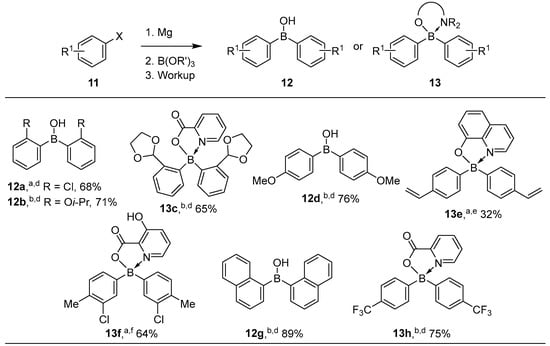
Scheme 4.
Synthesis of substituted diarylborinic acids and derivatives. (a) B(OMe)3 was used. (b) B(On-Bu)3 was used. (c) B(Oi-Pr)3 was used. (d) X = Br, (e) X = Cl, (f) X = I.
In general, good yields are obtained whatever the substitution pattern on the aromatic ring. Furthermore, electron-withdrawing (i.e., 12a [24], antibacterial agent 13f [25], 13h [15]) and -donating (12b [6,26], 12d) [7] substituents are tolerated, as well as napththyl groups (i.e., 12g, a 1,2-diol complexing agent for absolute configuration prediction) [27]. However, the reaction is less efficient for para vinyl-substituted borinic acid 13e [28], probably because of the potential reaction of the styrenyl moiety with the Grignard reagent. This is a main drawback of this strategy because only functional groups compatible with Grignard reagents (or organolithium) and acidic workup are allowed, which considerably narrows the scope of the reaction. However, the recent method reported by Zou et al. using water instead of HCl for the hydrolysis, enables the synthesis of diketal 13c in a good 65% yield [15].
Non-symmetrical borinic acids are of particular interest for applications in medicinal chemistry or materials science. For instance, in the course of their study on borinic-acid-containing polymers as chemical sensors, Wan et al. used a one-pot synthesis of monomers 16a–c by the sequential addition of Grignard reagent on trimethoxyborane (Scheme 5) [29,30]. The reaction of the Grignard of 14 with B(OMe)3 produced boronic ester 15, which was in situ reacted with the other Grignard (i.e., 18) derived from p-bromostyrene. By careful control of the temperature and the stoichiometry, polymerizable borinic acids 16a–c were selectively obtained in good yields after purification on column chromatography.
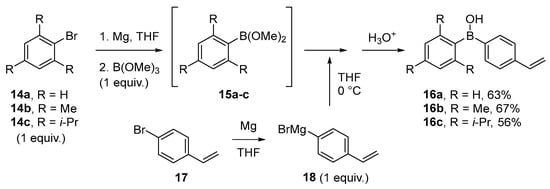
Scheme 5.
Synthesis of polymerizable borinic acids 16a–c.
Such a strategy has also been exploited with aryllithium species for the synthesis of diborinic acid derivatives 23 that display strong inhibitory activity on store-operated calcium entry[10]. Starting from commercially available arylbromides 21, lithiation at a low temperature, then borylation with B(Oi-Pr)3, afforded intermediates 22, ready to react with preformed bis-phenyllithium 20 (Scheme 6). Hydrolysis, then esterification with ethanol amine afforded a range of bis-borinic acid derivatives 23 tethered by a biphenyl or an ether linker.
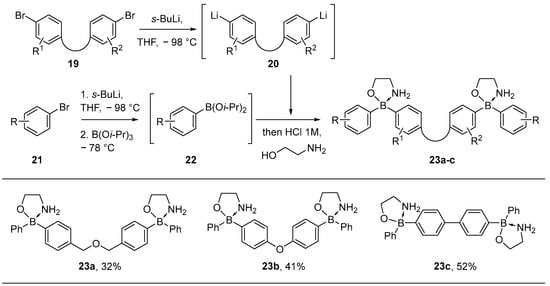
Scheme 6.
Synthesis of diamino borinates 23a–c by in situ generation of borinic esters.
Cyclic analogues of borinic acids are an important subclass of B-containing heterocycles. They have been used for several applications such as catalysts for regioselective activation of polyols or epoxide opening [31], building blocks in double Suzuki coupling [32,33], sensors [34] or fluorescent emitters [35]. A straightforward method to access these heterocycles relies on the reaction of an electrophilic boron reagent with a diaryllithium species, which can either be generated by halide–lithium exchange or by directed ortho-metalation. As described in Scheme 7, the halide–lithium exchange strategy has been successfully applied to the synthesis of various six-membered B-heterocycles such as azaborine 25a (used for catalysis) [36,37], methylene-bridged diarylborinic acid 25b [32], or fluorescent borinic acid 25c [34], a ratiometric sensor for H2O2. All these compounds were isolated in moderate to good yields whatever the source of borate reagent (B(On-Bu)3 or B(Oi-Pr)3). Borepinol derivatives 25d–e that embedded a seven-membered ring were also prepared by this strategy, albeit with more modest yields. For example, compound 25d [8] was isolated in a low 3% yield, which was attributed by the authors to the tedious purification and extensive decomposition of 25d over silica gel. In contrast, the aromaticity of borepinol 25e confers to the molecule stability towards air and moisture, and could be isolated with a 33% yield [35]. Interestingly, this compound proved to be an efficient probe to selectively bind dopamine over norepinephrine.
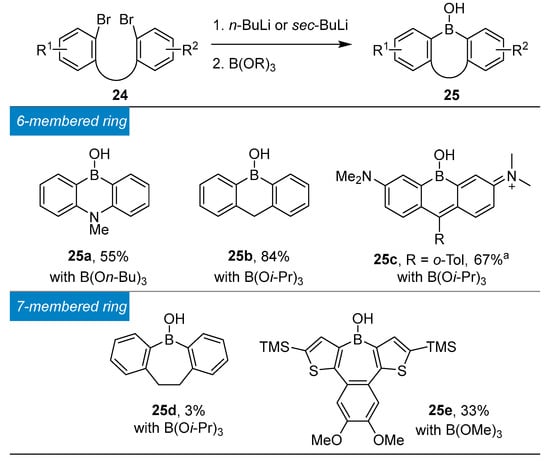
Scheme 7.
Synthesis of cyclic borinic acids 25. (a) Obtained after treatment with chloranil, then 6N HCl.
A related approach was described for the synthesis of 9,10-diboraanthracene 28 (a fluoride ion sensor) from triarylborane 26 (Scheme 8) [38]. Dilithiation of 26 with t-BuLi, followed by addition of trimethyl borate led to borinic ester intermediate 27. In this specific example, compound 27 was not hydrolyzed but was directly reacted with mesityl magnesium bromide to afford 28 with a 47% yield over three steps.

Scheme 8.
Synthesis of intermediate borinic ester 27.
An alternative synthesis of dibenzoxaborininols was developed by Fu et al. who proposed a double ortho-metalation of diarylethers 29 (or thioethers) with n-butyllithium/TMEDA, followed by trapping with trimethyl borate (Scheme 9) [39]. The method has been exemplified with more than twenty substrates, including symmetrical 30a and non-symmetrical borinic acids (30b–e) bearing alkyl (i.e., Me, Et, t-Bu) and methoxy substituents. It is worth mentioning that in the case of 30b, the regioselectivity is dictated by the lithiation step, which occurs between the MeO and ArO group thanks to an additional coordination of the organolithium reagent. In the naphthalene series (i.e., 30e), however, a competitive deprotonation at the C1 and C3 positions takes place, with the latter always observed as the major regioisomer. It is interesting to note that these cyclic borinic acids were successfully transformed into dibenzofuran derivatives under palladium catalysis. The same strategy was applied to diaryl thioether, although the corresponding thia-boraanthracene 30f was isolated with only a 20% yield, reflecting the lower ability of sulfur to direct ortho-metalation [36].
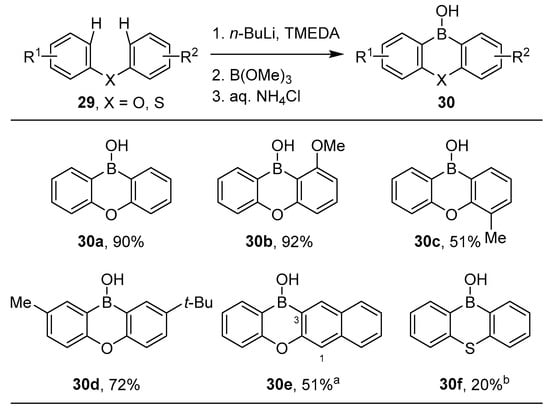
Scheme 9.
Synthesis of cyclic borinic acids by ortho-metalation. (a) Traces of the C1 regioisomer were observed. (b) B(On-Bu)3 was used.
In 2020, Uchiyama et al. described an original nucleophilic diboration of alkynes to build up boron-doped PAHs 32 (Scheme 10) [40]. Bromo-naphthalenes 31 were converted into the aryl lithium species with n-BuLi at low temperature, then reacted with bis(pinacolato)diboron at room temperature. After workup, cyclic borinic acids 32 were obtained in modest to excellent yields, depending on the alkyne, the aromatic substitution and the nature of the diboron reagent.
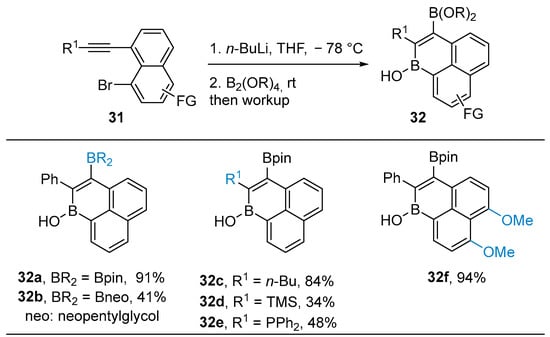
Scheme 10.
Synthesis of boron-doped PAHs 32 by nucleophilic diborylation of alkynes 31.
The reaction proceeds by formation of a sp2-sp3 diboron intermediate 33, which undergoes intramolecular nucleophilic attack of the formal boryl anion onto the suitably positioned triple bond (Scheme 11). Consecutive intramolecular addition of the newly formed carbanion (i.e., 34) on the boronic ester led to the cyclized product 32 after hydrolysis.

Scheme 11.
Proposed mechanism for the diborylation of alkynes.
2.1.2. Use of Borontrihalides
In comparison to trialkoxyboranes, the corresponding boron trihalide reagents are significantly more reactive due to the enhanced Lewis acidity at the boron centre. These reagents are thus particularly adapted for the synthesis of diarylborinic acids bearing hindered ortho-substituents or electron-withdrawing groups. As highlighted in Scheme 12, borinic acid 36a substituted by electron-deficient CF3 groups was prepared from 35a by addition of the corresponding organolithium species onto BCl3, followed by hydrolysis [41]. A detailed study of this reaction showed that a chlorine/fluorine exchange (from the CF3 substituent) occurred during the reaction to afford a mixture of Ar2BCl and Ar2BF [42]. Hydrolysis afforded borinic acid 36a in a 59% isolated yield even though both fluoro- or chloro-diarylboranes were formed. The analogous dimesityl borinic acid 36b was obtained with a 58% yield by the addition of the Grignard reagent of 35b on boron trifluoride dimethyl etherate [43].

Scheme 12.
Synthesis of diarylborinic acids using BCl3 and BF3·OMe2.
Access to the azaborine framework 39, bearing a free amine, has been described by using BCl3 as the borylating agent [44]. The authors showed that direct conversion of 37 in azaborine 39, by treatment with n-BuLi, then BCl3, resulted in a low yield (21%) (not shown). A more efficient stepwise method was then developed, consisting of prior protection of the aniline 37 by a TMS group followed by a lithiation/borylation/hydrolysis sequence. Overall, the isolated yield of azaborine 39 was significantly increased to 70% (Scheme 13).

Scheme 13.
Synthesis of azaborine 39 using BCl3 as borylating agent.
Spiro-borafluorene complexes (i.e., 43) have been studied for their particular structural features, perpendicular alignment between the ligand and the boracycle, which influence their physicochemical properties. As depicted in Scheme 14, the borafluorene unit can be prepared from biphenyl bromide 40, by a double lithiation followed by subsequent trapping with BCl3. Methanolysis of chloroborane 41 gave 42 and HCl as a byproduct, which was removed under vacuum. Treatment of 42 with 8-hydroxyquinoline then gave compound 43 with a 70% yield [45]. It is worth mentioning that direct reaction of the intermediate dilithium species with B(OMe)3 affords the diborylated compound (not shown) instead of the boracycle.

Scheme 14.
Synthesis of borafluorene derivative 43.
Fukushima et al. showed that chloroborafluorene 41 can be transformed into the trifluoromethane sulfonyloxy analog 44 by treatment with TMSOTf (74% yield) (Scheme 15) [46]. This highly reactive intermediate was then engaged in a 1,2-carboboration of alkynes to produce borepines 45a–c in excellent yields. DFT calculations indicate that borafluorene and diphenylacetylene first form a complex by coordination of the alkyne to the lone orbital of the boron. This complex then evolves into the formation of the borepine 45, by a four-membered transition state, resulting in the alkyne insertion in the B-C bond.

Scheme 15.
Synthesis of borepinol derivatives by carboborylation of alkynes.
During the course of their study on novel bifunctional organoboranes, Jäkle et al. designed diboradiferrocene 48 bearing a bis-borinic acid backbone (Scheme 16). In their initial studies, they observed that direct transmetalation of 1,2-bis(stannyl)ferrocene 46 with boron halides resulted in a rearrangement that produced 1,1′-bis(diboryl)ferrocene (not shown). This issue was circumvented by first reacting 46 with HgCl2 (i.e., 47), then with BCl3 [47]. The dichloroborane intermediate was next subjected to methanolysis with TMSOMe, to avoid the formation of HCl and prevent decomposition. Hydrolysis eventually led to bis(borinic acid) 48 with a 16% yield [48].

Scheme 16.
Synthesis of diboradiferrocene 48.
2.1.3. Use of Aminoboranes
Despite many applications of B(OR)3 and BX3 as borylating agents, their main drawback relates to the difficulty of controlling the number of aryl residues transferred to the boron centre (see Scheme 2). In the early sixties, Coates et al. described the use of diarylaminodichloroboranes (Cl2B-NAr2) for the selective preparation of diarylborinic acids (Scheme 17a) [49]. These borylating agents display two important features: (1) they are monomeric in solution when the aryl is a sterically hindered group (Ar = Ph, o-Tol or Mes), and (2) the presence of the amino group on the boron reduces its Lewis acidity by donation of the nitrogen lone pair to the boron vacancy. These properties give a borylation agent in which the boron atom is electrophilic enough to react with two equivalents of Grignard reagents, but prevent the third addition. Thus, with only a slight excess of arylmagnesium bromide 49, diarylborinic acids 51 were obtained in yields ranging from 45% to 88%. In 2017, Clark et al. illustrated the synthesis of cyclic borinic acids 52a–c by a similar strategy. While reaction of the dilithium intermediate with B(OR)3 reagents resulted in low yields, the authors found that the use of dichloro(diisopropylamino)borane led to improved yields of azaborines 53a–c (Scheme 17b) [22].

Scheme 17.
Synthesis of borinic acids 51 and 53a–c using aminodichloroboranes. (a) [49]; (b) [22].
Our group proposed diisopropylaminoborane 57 (DIPOB) as the borylating agent for the synthesis of symmetric and unsymmetrical borinic acid derivatives under non-cryogenic conditions. The reaction selectively gives diarylborinic acids even when a slight excess of arylbromide 54 (2.2 equivalents) is employed (Scheme 18) [50,51]. No boron impurities were observed, and the products were obtained by precipitation without the need of flash chromatography. Although DIPOB is easy to synthesize from low cost starting materials, this air and water sensitive reagent needs to be prepared by the thermolysis of diisopropylamine–borane complex 58 (DIPAB) and stored under an inert atmosphere. As a convenient alternative, we showed that DIPOB can be easily in situ generated from water- and air-stable DIPAB, by treatment with a catalytic amount of a Grignard reagent [52]. Overall, both methods gave borinates 56 in good to excellent yields after precipitation of the borinic acids with a suitable amino alcohol.

Scheme 18.
Synthesis of symmetrical borinic acid derivatives 56.
Regarding the dehydrogenation of DIPAB, we hypothesized that, in the initial step, the Grignard reagent deprotonates DIPAB 58 to give aminoborohydride 59. The latter is basic enough to undergo deprotonation of DIPAB 58, generating DIPOB 57, aminoborohydride 59 and hydrogen as the sole side product (Figure 2).
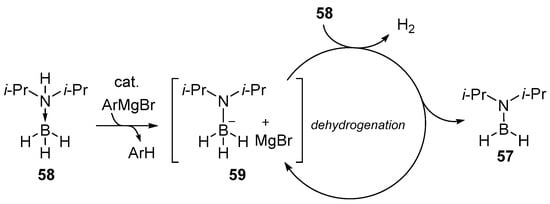
Figure 2.
Proposed mechanism for dehydrogenation of DIPAB 58.
2.2. By Organometallic Catalysis with Boron Reagents
The syntheses of diarylborinic acids described so far rely on organolithium or organomagnesium reagents that considerably narrow down the functional groups’ compatibility. Chatani et al. recently reported the palladium-catalyzed synthesis of cyclic borinic acids from diarylbromides or triflates 60 and DIPOB 57 [33]. The main advantage of this catalytic strategy is undoubtedly the large tolerance towards sensitive functional groups providing access to symmetrical and non-symmetrical cyclic borinic acids bearing ester, nitrile, etc. (Scheme 19). Furthermore, borinic acids that embedded oxygen (61a–c), nitrogen (61d), sulfur (61e) or alkenyl (61f) tethers were prepared in good yields when compared to the known methods.

Scheme 19.
Synthesis of cyclic borinic acids catalyzed by palladium with DIPOB 57.
The reaction proceeds through a sequential diborylation process (Figure 3), similarly to organolithium reagents. It is known that the reaction of arylhalides with DIPOB under palladium catalysis leads exclusively to arylaminoborane 62, due to steric congestion of the diisopropyl amine [53]. However, in this particular case, an intramolecular reaction probably facilitates the second borylation, leading to 63, and then 61 after hydrolysis.

Figure 3.
Proposed mechanism of the Pd-catalyzed diarylation of aminoboranes.
Later on, the approach was extended to the synthesis of acyclic borinic acid derivatives by the same group [54]. As mentioned above, the use of DIPOB only resulted in the formation of boronic acids under palladium catalysis. Thus, after the screening of various substituted aminoboranes, and investigating their aggregation state (monomer versus dimer form), they found that the less bulky diethylaminoborane reagent 64 affords a good compromise in terms of reactivity at 100 °C (Scheme 20). Under optimized conditions, symmetrical and non-symmetrical borinic quinolates 66 were obtained in modest yields. Interestingly, the reaction is compatible with an ester moiety (i.e., 66c), although the isolated yield is pretty low.
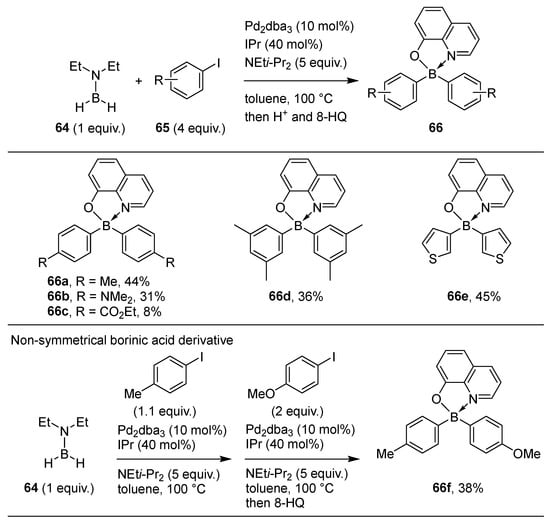
Scheme 20.
Borinic acid synthesis by palladium-catalyzed diarylation of diethylaminoborane.
2.3. By Electrophilic Aromatic Substitution with Boron Reagents
Borylation by electrophilic aromatic substitution is an alternative route to prepare organoboron compounds, which has been applied in few examples for the synthesis of borinic acids. The regioselectivity of the SEAr is often controlled by a combination of steric and electronic properties of the substituents on the aromatic moiety. When arylstannanes or arylsilanes substrates are used, the boron electrophile reacts at the ipso position, resulting in an exchange of the Sn/Si by a boron atom.
In an early report in 1984, Thorpe et al. showed that diboranes react with arylstannanes 67, to provide symmetrical borinic acids 68, in modest yields, after hydrolysis (Scheme 21) [55]. Usually, a mixture of boronic and borinic acid was observed, depending on the substitution pattern and the BH3/substrate ratio.
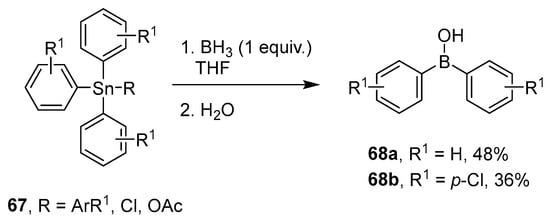
Scheme 21.
Synthesis of borinic acids by tin–boron transmetalation.
A two-step intermolecular process was recently described by Wagner et al. for the synthesis of polycyclic bis-borinic acid 72, a compound developed for its optoelectronic properties. The first transmetalation takes place by reacting bis-silane 69 with BBr3 at 120 °C, to produce bis-dibromoborane 70 (Scheme 22) [56,57]. The latter undergoes a second transmetalation reaction with 69, leading to the desired bis-bromoborane 71 with a 52% yield. The corresponding borinic acid 72 was then obtained with an 80% yield by hydrolysis in wet acetone.

Scheme 22.
Synthesis of bis-borinic acid 72 by Si/B transmetalation.
A similar strategy was used by the group of Wang to prepare spiro-BODIPYs 75a–b, starting from tethered diarylsilanes 73a–b (Scheme 23) [58,59]. Treatment of 73a–b with BBr3 afforded the cyclic diarylbromoboranes 74a–b by two consecutive inter-, then intramolecular transmetalation steps. Subsequent reaction with in situ generated dipyrromethene led to the spiranic compounds 75a–b in good yields. Of course, the corresponding borinic acids could also be synthesized by the hydrolysis of compounds 74a–b as exemplified in Scheme 13.

Scheme 23.
Synthesis of 75a–b by Si/B transmetalation.
Despite transmetalation of arylsilanes and stannanes, the directed electrophilic C–H borylation is an effective way of controlling the regioselective functionalization of arenes, heteroarenes or alkenes under metal-free conditions. In this regard, Suga et al. reported the C−H borylation of bis-thiophene derivatives 76 using BCl3 (Scheme 24) [60]. The authors showed that the tandem demethylation and subsequent Friedel–Craft-type borylation was effective in the presence of BCl3, triethylamine, and n-BuN4I. Thus, by carrying out the reaction at 135 °C (i.e., 77a) or rt (i.e., 77b) in PhCl, the intermediate chloroborane is formed, and directly treated with mesityl Grignard reagent to give 77a–b with excellent yields.
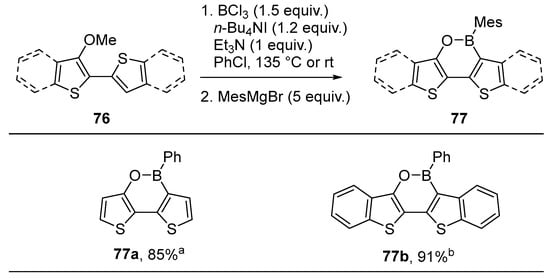
Scheme 24.
Synthesis of mesityl-substituted borinic ester 77a–b by electrophilic borylation. (a) Reaction performed at 135 °C. (b) Reaction performed at room temperature.
The proposed mechanism starts by complexation of the boron atom to the methoxy group to produce 78a (Scheme 25). The demethylation process is then favored by the iodide ion, affording dichloroborane 79a. Subsequent intramolecular borylation gave 80a, which was reacted with MesMgBr to obtain 77.

Scheme 25.
Proposed mechanism of electrophilic borylation of 76a.
Electrophilic borylative cyclization of triarylamines is a straightforward strategy to prepare BN-doped polycyclic aromatic hydrocarbons (Scheme 26). Hatakeyama et al. showed that the reaction of 12 equivalents of BI3 with polysubstituted 1,3,5-triarylamine 81a resulted in a quadruple borylation process [61]. The target borinic acid 82a was isolated with a 35% yield, albeit with 3% of triborylated derivative and a large amount of side products. Other boron trihalide reagents (BCl3 or BBr3) did not react in this particular example. Colman and his group recently described the synthesis of triborinic acid 82b in the presence of 18 equivalents of BBr3 at 200 °C [62]. Even though these conditions are pretty harsh, triborinic acid 82b was isolated with a good 68% yield.

Scheme 26.
Electrophilic borylation of triarylamines 81a–b.
Ingleson and coworkers developed a synthesis of 1-boraphenalenes relying on the electrophilic borylation of alkynes 83, substituted with appropriate aromatic rings (Scheme 27) [63,64]. Initially, borylation with BBr3 resulted in the formation of the rearranged product 84 after hydrolysis, along with byproducts derived from the addition of HBr to the triple bond (HBr is formed after the SEAr reaction). By adding 2,4,6-tri-t-butylpyridine to the reaction, extended boron-doped polycyclic aromatic hydrocarbons (PAHs) 84 were synthesized in good yields.
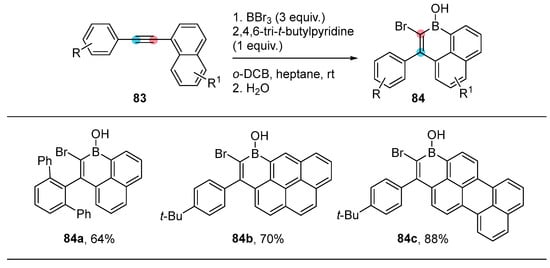
Scheme 27.
Synthesis of extended boron-doped PAH 84 by electrophilic borylation.
The unexpected formation of polycyclic borinic acids 84 was rationalized by evoking first an electrophilic borylation of the alkyne 83 to form 85 (Scheme 28). The subsequent intramolecular Friedel–Craft reaction onto vinylic carbocation (85 to 86), tautomerization (86 to 87), and then C–C bond cleavage results in carbocation 88 that undergoes 1,2-migration of bromide (i.e., 89). Intramolecular electrophilic borylation (i.e., 90) and hydrolysis provide cyclic borinic acid 84.
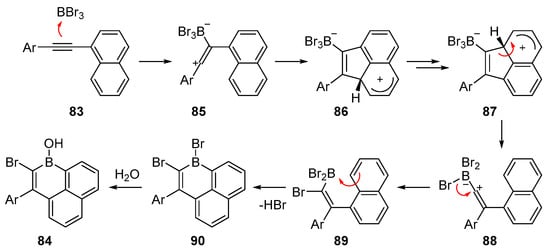
Scheme 28.
Proposed mechanism for the borylative cyclisation of 83.
In addition to the use of trihalogenoboranes in electrophilic C–H arene borylation, it has recently been reported that NHC-borenium is also effective in this transformation [65,66]. Three-coordinate NHC-borenium cations are strongly electrophilic boron compounds that can be generated from the air- and moisture-stable NHC-boranes and a strong acid. Würthner et al. recently developed a synthesis of cyclic borinic acids relying on this chemistry study (Scheme 29); the NHC-borenium species is first generated from 1,3-diisopropylimidazol-2-ylidene borane 91 and HNTf2 [67,68,69,70]. The subsequent addition of 92, led to the cyclic NHC-borane intermediate 93. The reaction pathway follows a sequential regioselective hydroboration of alkenes and C–H borylation of the aromatic scaffold. After dehydrogenation of 93 under oxidative conditions and aqueous workup, borinic and bis-borinic acids 94a–d were isolated in modest yields ranging from 15% to 49%.
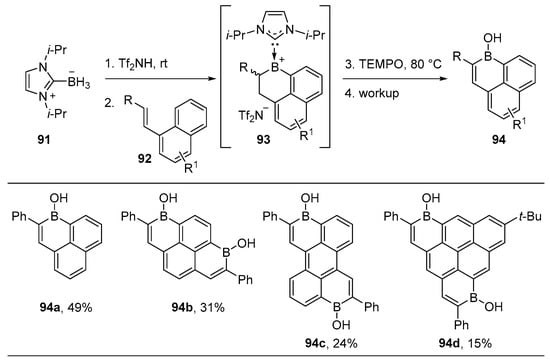
Scheme 29.
Synthesis of cyclic borinic acids 94 via electrophilic borylation with NHC-borenium.
To summarize, an overview of the different borylating agents and general methods to synthesize borinic acid derivatives through the formation of two C-B bonds is given in Scheme 30. Overall, these approaches have been used to prepare a wide range of acyclic, cyclic, symmetric and non-symmetric borinic acids, and their corresponding chelates. The field of applications of these compounds mainly lies in catalysis, cross-coupling, medicinal chemistry, sensors, polymers and luminescent devices.
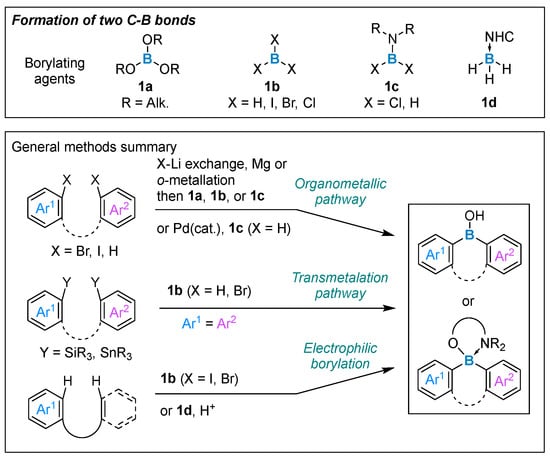
Scheme 30.
Overview of the synthetic methods relying on the formation of two C-B bonds.
3. Formation of One Carbon–Boron Bond
3.1. By Nucleophilic Addition of ArLi and ArMgX to Aryl Boron Reagents
The addition of organolithium or Grignard reagents to arylboranes is closely related to the previous methods using trialkylborates or trihalogenoboranes. The main advantage of this approach is the possibility to introduce two different aryl substituents at the boron, allowing for the synthesis of non-symmetrical borinic acids.
As shown in the examples in Scheme 31, the nucleophile can be either aryllithium 95a or arylmagnesium halide 95b, which reacts with boronic esters 96 bearing pinacol, neopentyl glycol or alcohol (OMe, OEt) ligands.
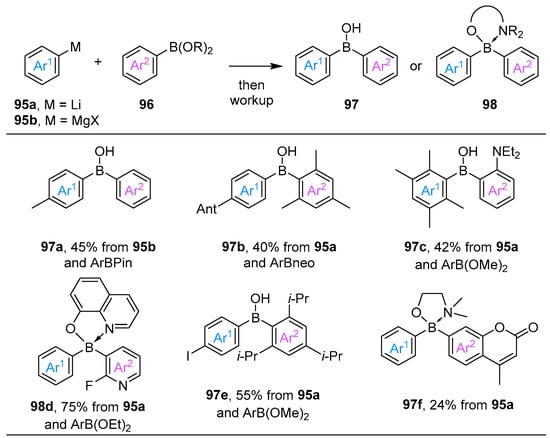
Scheme 31.
Synthesis of acyclic non-symmetrical borinic acids by organometallic addition on boronic esters.
For example, the reaction tolerates aromatic rings substituted with methyl, aryl or amino groups (97a–c) on the organometallic reagent 95 or the boronic acid partner 96 [17,71,72]. The addition of aryllithium onto heteroaromatic boronic esters also performs well, as shown with pyridine-substituted boron quinolate 98d obtained with a good yield [73,74]. Even more interesting is the possibility of incorporating an iodine atom such as in borinic acid 97e [75]. In brief, monolithiation of 1,4-diiodobenzene, followed by the addition onto the corresponding boronic ester, led to 97e that can be further functionalized by Still coupling thanks to the remaining iodine substituent. This method was also used to prepare borinic acid 97f derived from coumarin, a new probe to monitor H2O2-mediated signaling processes [76].
Dihalogenobenzenes have also been used in the one-pot synthesis of functionalized non-symmetrical borinic acid derivatives (Scheme 32) [77]. In this approach, diiodo- or dibromo arenes 99 are treated with one equivalent of n-BuLi, then the corresponding aryllithium is added to the phenyl boronic ester 100 at −78 °C. A second halogen–lithium exchange takes place by reacting the resultant “ate” complex 101 with t-BuLi at −110 °C. The dianionic species (not shown) is then trapped with various electrophiles (DMF, isocyanate, chlorosilane, disulfide) to provide unsymmetrical boron quinolate complexes 102 with good isolated yields.
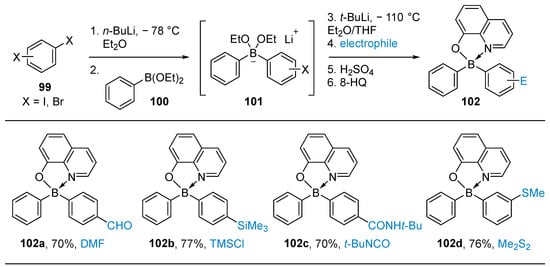
Scheme 32.
Synthesis of non-symmetrical borinic acid derivatives 102 through lithium “ate” complexes.
The synthesis of 9,10-diboraanthracenes 104 has been described by the same group, but this time starting from 2-bromophenyl boronate esters 103 (R = Me, Et, i-Pr) (Scheme 33) [78]. For instance, the reaction of 103 performed with an excess of t-BuLi (2 or 4 equivalents) at low temperature provided borinic acids 104 in modest yields [79].
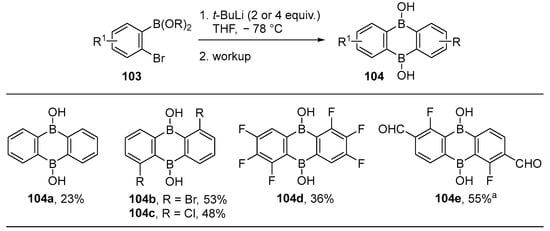
Scheme 33.
Synthesis of 9,10-diboraanthracenes 104. (a) From boronic ester 103e, R1 = CH(OMe)2.
Scheme 34 provides a mechanistic proposal for the formation of 104. In line with the computational studies they performed, the authors showed that the Br/Li exchange with t-BuLi to produce 105 is kinetically favored over nucleophilic attack at the boron atom. The lithium adduct 105 then reacts with the remaining starting boronic ester 103 to form “ate” complex 106. A second Br/Li exchange (i.e., 107) followed by subsequent cyclization (i.e., 108) afforded diborinic acids 104 after hydrolysis. Although an alternative pathway involving the dimerization of 105 was proposed, it seems unlikely due to the low concentration of the lithiated boronate species 105 under the developed protocol.

Scheme 34.
Proposed mechanism for the formation of 9,10-diboraanthracenes 104.
An interesting synthetic application of these compounds was highlighted by Wagner and coworkers who designed bis-BO-perylene derivatives from 9,10-diboraanthracenes 104b (Scheme 35) [80,81,82]. In short, bis-alkynylation of 104b by a Stille-type coupling (i.e., 109) followed by gold-catalyzed twofold cyclisation of the borinic acid 109 onto the triple bond, produced boron-based perylenes 110a–b in excellent 89% yields. These compounds undergo reversible reduction, and could be used for organic electronics.

Scheme 35.
Synthesis of polycyclic borinic esters 110 by gold-catalyzed hydroalkoxylation of alkynes.
An intramolecular variation was proposed recently to prepare strained spiro boron quinolates 113 (Scheme 36) [45]. Under the same conditions as Scheme 33, bromo boronic ester 111 was converted into the lithium “ate” complex 112. After quenching with TMSCl, borinic acids were isolated in good yields as the quinolate complexes 113a–b.

Scheme 36.
Synthesis of borinic acid derivatives 113a–b by intramolecular borylation.
Aryl halogenoboranes can also be used as precursors of non-symmetrical borinic acid derivatives, as exemplified by Bolm and Helten during the course of their study on BO-containing hybrid polymers [83,84]. A model substrate, para-substituted bis-dibromoborane 114, was reacted with lithium 2,4,6-triisopropylphenyl (TipLi) to give the corresponding bis-diarylbromoborane (Scheme 37). The authors then tried to form the B-O bond in the presence of silylated phenol PhOSiMe3. However, the Si/B exchange was very slow and the conversion was not complete even after several weeks. The reaction with PhOH and trimethylamine appeared to be much cleaner, leading to 115 with a 58% overall yield.

Scheme 37.
Synthesis of diborinic ester 115.
The addition of organolithium and Grignard reagents on 9-chloro-oxaboraphenanthrene 116 was investigated as a route to borinic ester derivatives (Scheme 38). Both nucleophiles were convenient in this transformation; however, aryllithium led to a mixture of single (i.e., 117) and double additions to form the lithium borate (not shown). In contrast, Grignard reagents gave compounds 117a–e with excellent isolated yields, even for those bearing sterically hindered group (117c) or electron-deficient substituents (117d–e) [85].
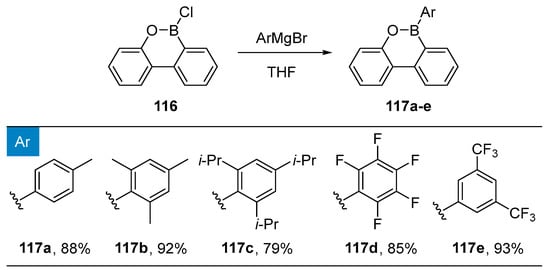
Scheme 38.
Synthesis of 10,9-oxaboraphenanthrenes 117.
An original synthesis of 1,4-azaborazine has been described starting from enamine 118 (Scheme 39), obtained in three steps from 2-bromo aniline [86]. Bromide–lithium exchange followed by trapping with vinylchloroaminoborane 119 gave diene 120. Ring closure metathesis with Grubbs’ 2nd generation catalyst and methanolysis quantitatively delivered borinic ester 122. This compound was used as a platform for the design of ligands incorporating the 1,4-azaborine motif.

Scheme 39.
Synthesis of methoxy-substituted 1,4-azaborazine 122.
3.2. By Electrophilic Aromatic Substitution with Aryl Boron Reagents
Early examples of borinic acid synthesis via intramolecular electrophilic borylation were reported by Bickelhaupt and coworkers in 1972 (Scheme 40). The reaction was carried out by pyrolysis at 220 °C of boroxine 123, in combination with lithium aluminum hydride and tributoxyborane, to afford borinate 124 with a 49% yield after treatment with ethanolamine [87]. The authors proposed that the reaction may occur through the formation of a primary aryl borane (ArBH2), or a butoxy derivative such as ArB(H)(On-Bu) or ArB(On-Bu)2. Alternatively, the same product was obtained with a similar yield by pyrolysis of the pyridine complex 125 [88].

Scheme 40.
Synthesis of 124 by pyrolysis of organoboranes 123 and 125.
As described before, recent developments in the field of electrophilic borylation rely on the use of more reactive boron species (BX3, ArBX2, etc.) to perform the reactions in practical conditions of temperature. In this regard, Suga et al. reported the C−H borylation of thiophene derivatives using PhBCl2 (Scheme 41) [60]. Although the reaction works well on the corresponding hydroxyl analog of 126, the starting material was difficult to obtain and unstable. By contrast methoxythiophene derivatives 126 are easy to prepare and handle, and their synthesis is versatile. The authors showed that the treatment of thiophene 126 with PhBCl2 alone did not result in the cyclized product. However, the tandem demethylation and subsequent Friedel–Craft-type borylation was effective in the presence of triethylamine and a stoichiometric (or catalytic) amount of n-BuN4I. Thus, by carrying the reaction at 135 °C in PhCl, a series of dithieno-1,2-boxaborines 127a–d was obtained in excellent yields whatever the nature of the second aromatic ring. The mechanism is related to the one already described in Scheme 25.
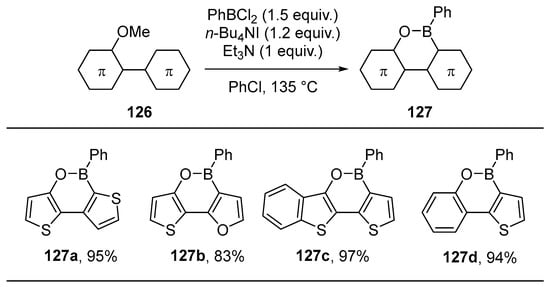
Scheme 41.
Synthesis of BO heterocycles 127 by electrophilic borylation with PhBCl2.
In the course of their study on 1,2-carboboration of ynamides with aryl dichloroboranes, Studer et al. described the one-pot synthesis of boraphenalene 131 (Scheme 42) [89]. Regioselective borylation of ynamide 128 with napththyl dichloroborane 129 in chloroform furnished intermediate 130. Subsequent treatment with AlCl3 and dichloropyridine provided boraphenalene 131 with a 71% yield by intramolecular boron Friedel–Crafts arylation.

Scheme 42.
Synthesis of borinic acid 131 by sequential arylboration/electrophilic borylation.
As seen in the previous section, the transmetalation of arylstannanes is a powerful way of controlling the regioselectivity of the borylation of BX3. Within the framework of borinic acid synthesis, the method was extended to the reaction with ArBBr2 (Scheme 43) [90,91,92]. Several electron-deficient borinic acids 134a–b or boron quinolate complexes 135a–c were obtained in modest to good yields. The reaction seems compatible with a range of functional group such as nitro, boronic ester, vinyl, etc.
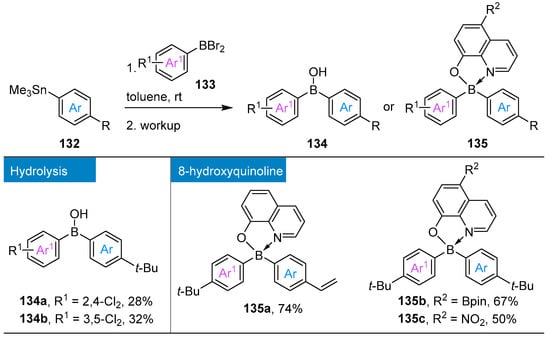
Scheme 43.
Synthesis of borinic acid derivatives 134–135 by transmetalation with ArBBr2.
3.3. Other Methods
As seen previously, one of the main methods to prepare borinic acid derivatives relies on the use of organometallic reagents (ArLi or ArMgX), which strongly limits the functional group tolerance. Recently, Lee and coworkers reported a metal-free one-pot synthesis of tetracoordinated borinic acids (Scheme 44) [93]. The optimal conditions require nine equivalents of boronic acids 136, in the presence of a bidentate ligand 137 and K3PO4 (3 equiv.) in refluxing 1,4-dioxane. The reaction performs well with substrates incorporating electron-withdrawing (138a) or -donating (138b) groups on the aromatic ring. Remarkably, styryl boronic acid led to the corresponding boron quinolate 138c with a good 79% yield. The scope of the reaction was also extended to several N,O, N,N and O,O bidentate ligands as exemplified with compound 138d bearing a β-diketonate ligand. Preliminary mechanistic studies suggest that the reaction proceeds thought a boronic anhydride intermediate, with the formation of an “ate” complex and concomitant organic group transfer.
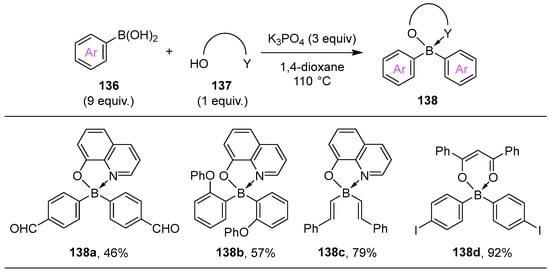
Scheme 44.
Ligand-promoted synthesis of boron(III) complexes 138.
A related transformation was recently developed by reacting stable potassium aryltrifluoroborates 139 with acylated 8-aminoquinolines 140, in the presence of p-tosyl chloride, manganese and sodium carbonate (Scheme 45) [94]. Since the aim of the study was to use these compounds as photoredox catalysts, the reaction was depicted on seven substrates. Nevertheless, yields ranging from 76% to 95% were obtained, with a good tolerance for p-methoxy (141b) and p-fluoro (141c) substituents.
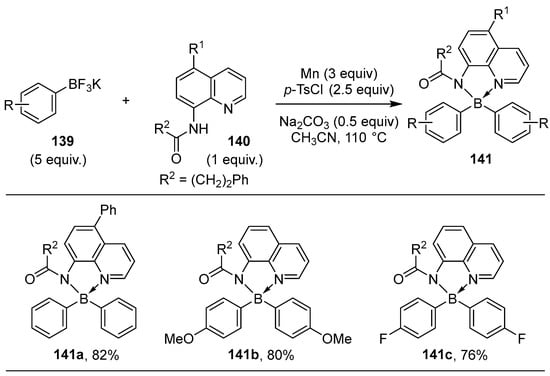
Scheme 45.
Synthesis of aminoquinolate diarylboron complexes from ArBF3K.
Within the framework of the synthesis of boron-doped anthracenes and pentacenes, Wagner and his coworkers disclosed the dimerization of aromatic 1,2-borohydrides 142 prepared by the reduction of the corresponding BPin adduct with LiAlH4. Hydride abstraction by Me3SiCl in dimethyl sulfide resulted in the cyclocondensed product 143 (Scheme 46) [95,96,97]. Subsequent hydrolysis afforded diborinic acid 144 with a good 82% yield over two steps.

Scheme 46.
Synthesis of diborinic acid 144 from arylborohydride 142.
2-Amino phenylboronic acids were used in an interesting intermolecular annulation with electron-deficient alkynes (Scheme 47) [98]. The reaction was conducted in CH2Cl2 in a sealed tube, either at 80 °C or 110 °C under microwave irradiation. It appeared that a high temperature was crucial to achieve the cyclisation and reach good conversions, without evidence of product degradation. Thus, excellent yields were generally obtained with dimethyl- or diethyl-substituted acetylene dicarboxylates (146a–b), as well as with electron rich (146c, 146e) or poor (146d) phenylboronic acids. The authors demonstrated that borinic acids 146 could be converted into indoles, under palladium catalysis.
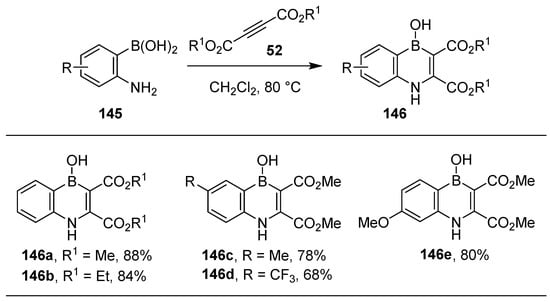
Scheme 47.
Synthesis of benzofused azaborinols 146.
The proposed mechanism implies a two-step process with first a conjugate addition of the aniline onto the triple bond, followed by trapping of the vinyl anion by the boron atom (Scheme 48).

Scheme 48.
Proposed mechanism for the formation of 146.
The reactivity of boronic acid 147 derived from aniline was illustrated by the synthesis of the red fluorophore 149, a xanthene analog (Scheme 49) [99]. In this particular example, 3-(N,N’-dimethylamino)phenylboronic acid 147 was treated with formaldehyde in acetic acid at 85 °C to form borinate 148. The latter was precipitated with sodium chloride under acidic conditions, leading to borinic acid 149 with a very low yield due to purification issues. It seems that once both aromatic rings have reacted with formaldehyde, the intermediate undergoes cyclization with the concomitant elimination of boric acid, and oxidation.

Scheme 49.
Synthesis of borinate-containing xanthene analog 149.
Dong et al. described an original synthesis of boron-containing heterocycles by boron insertion of MesBBr2 151 into a series of 2,3-dihydrobenzofurans 150 (Scheme 50) [100]. The reaction is catalyzed by a Ni(II) complex and requires a stoichiometric amount of Zn. Mechanistic investigations, supported by DFT studies, suggest that Zn plays a crucial role in the ring opening to form intermediate 152. Subsequent rebound is catalyzed by Ni(II), with Zn serving as a reductant. Boron heterocycles 153 that embedded a 5-, 6- or 7-membered ring were smoothly obtained in good to excellent yields.
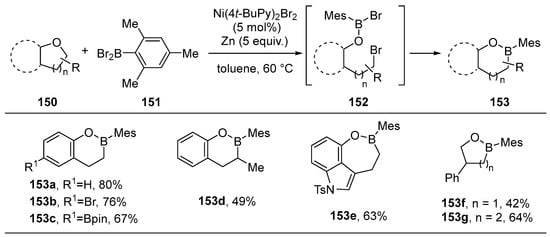
Scheme 50.
Synthesis of cyclic borinic acids 153 via boron insertion into alkyl ether bond.
The main synthetic methods involving the formation of one C-B bond are summarized in Scheme 51. The organometallic pathway has been extensively studied, and offers versatility in terms of molecular diversity (acyclic, cyclic, symmetrical and non-symmetrical) but suffer from a lack of functional compatibility. Other methods are more tolerant toward functionality, but they usually require specific substrates (incorporating a directing group or cyclic ethers, etc.), toxic reagents (tin derivatives), or an excess of organoboron derivatives (ligand exchange).
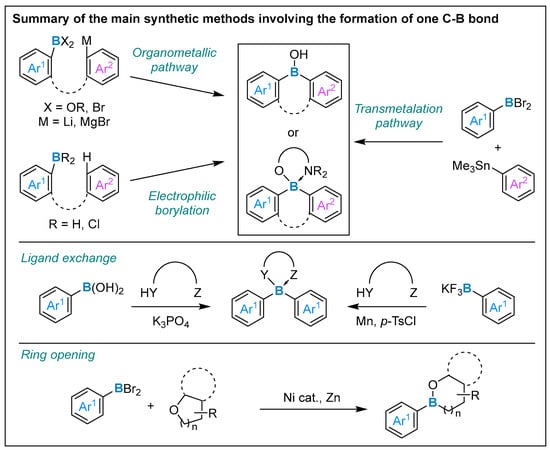
Scheme 51.
General methods for the synthesis of borinic acid derivatives via one C-B formation.
4. Cleavage of One C-B Bond
4.1. Synthesis of Four-Coordinated Borinic Acids from Triaryl Boranes
Four-coordinated diarylborinic acids bearing π-conjugate bidendate ligands have been widely studied for their luminescent properties and applications in optoelectronics (OLED, organic field-effect transistors, imaging materials, etc.) [14]. One of the main and straightforward methods to access such structures relies on the reaction of triarylboranes with a suitable bidentate ligand. Since the reaction proceeds through a protodeboronation process, the presence of an acidic proton on one of the heteroatoms of the ligand is mandatory. Because of this particular mechanism, most of the examples describe the use of triarylboranes bearing three identical aryl groups in order to prevent any mixture of different diarylborinates. As shown in Scheme 52, a large variety of ligands on the organoborinates have been employed and can be sorted into three main categories: N,O-ligands [101,102,103,104,105,106,107,108,109,110,111,112,113,114,115,116,117,118,119,120,121,122,123,124,125,126,127,128,129,130,131,132,133,134,135,136], N,N-ligands [110,137,138,139,140,141,142,143,144,145,146,147,148,149,150,151,152,153,154,155,156,157,158,159,160,161,162,163,164,165,166,167,168] and O,O-ligands [169,170,171,172,173,174,175,176]. Most of these examples describe the synthesis of diphenylborinates from commercially available triphenylborane.
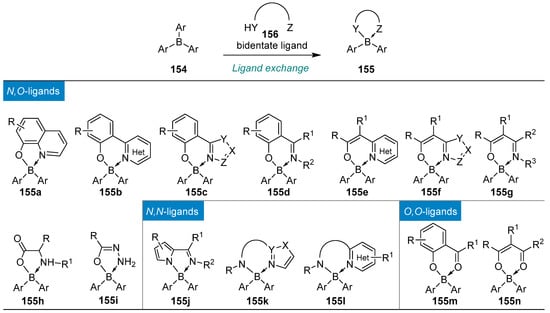
Scheme 52.
Overview of the bidendate ligands used in the synthesis of diarylborinates 155.
A typical example is illustrated in Scheme 53 with the synthesis of the highly fluorescent dyes 157 reported by Ulrich et al. [116]. The borate complex 157 was obtained by reacting 2,5-bis(benzooxazol-20-yl)hydroquinone 156 with six equivalents of triphenylborane in toluene at 60 °C. After recrystallization, pure compound 157 was isolated with a 93% yield.

Scheme 53.
Example of the synthesis of a diborinate complex 157 using Ph3B.
Four-coordinated diarylborinic acids bearing functionalized aromatic moieties or heteroaromatics [103], have also been reported from triarylboranes (Scheme 54). For instance, non-commercially available triarylboranes can be easily prepared by reacting an organolithium species with tribromoborane [101,102,103]. Subsequent treatment of the triarylborane 159 with 8-hydroquinoline in THF afforded 160a–c in good yields over two steps. Interestingly, compounds 160a–b are stable enough to be used in post-functionalization processes such as palladium-catalyzed Sonogashira coupling (i.e., 160a) [102], or ruthenium-catalyzed ring closure metathesis (i.e., 160b) leading to dibenzoborepines [101].
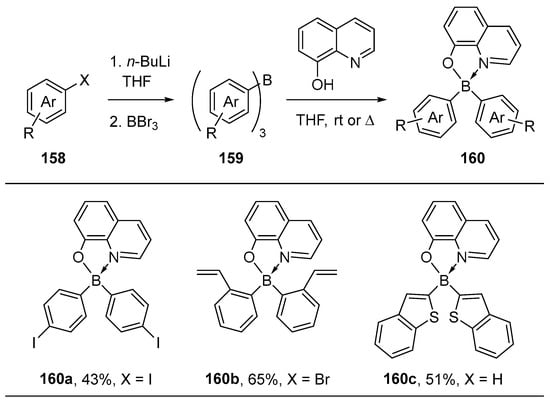
Scheme 54.
Synthesis of functionalized diarylborinate complexes.
In 2018, Sarpong et al. developed an elegant synthesis of a new class of oxazaborinines, combining Lewis acid activation (R3B) with Pd-catalyzed rearrangement [177]. The reaction of triphenyl- or triethylborane 161, with enaminones 162 under palladium catalysis afforded oxazaborinines 163a–c in excellent yields, via in situ generation of the N,O-ligands (Scheme 55).
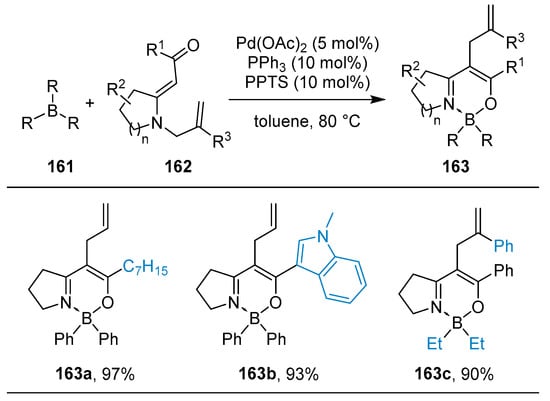
Scheme 55.
Synthesis of oxazaborinines 163 by Pd-catalyzed rearrangement.
As outlined in Scheme 56, the reaction proceeds through the formation of iminium 164, by coordination of the enaminone with borane 161. Next, a C-N bond activation occurs in the presence of palladium and Brønsted acid catalyst to generate boron enolate 165 and palladium π-allyl complex 166. Eventually, allylic alkylation of the latter gave rise to the allyl-substituted oxazaborinine 163.

Scheme 56.
Proposed mechanism for the formation of oxazaborinines 163.
Stanley et al. reported the direct synthesis of oxaboranes 170, through a Ni-catalyzed three-component cyclocondensation (Scheme 57) [178]. The versatility of the reaction was illustrated with more than 30 examples, using (hetero)aromatic aldehydes 167, symmetrical or non-symmetrical alkynes 168, and triphenylborane 169. A variety of oxaboranes 170 was isolated in moderate to excellent yields (47–99%), with high regioselectivities (i.e., 170d, regioisomeric ratio 10.5/1). The reaction proceeds through the formation of an oxanickelacyclopentene by oxidative cyclization with the aldehyde and alkyne, followed by subsequent transmetalation with triphenylborane 169. These oxaboranes 170 proved to be valuable intermediates for further applications in organic synthesis.
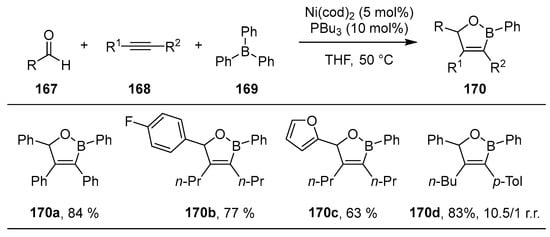
Scheme 57.
Ni-catalyzed synthesis of oxaboranes 170.
In 2020, Melen et al. described an original access to dienolate-coordinated borinic acids by carboboration of iodonium ylides (Scheme 58) [179]. They showed that mixing triarylboranes 171 with an equimolar amount of acyclic symmetrical or unsymmetrical iodonium ylides in toluene afforded compounds 173a–d in good yields. DFT calculation revealed that the mechanism proceeds through coordination of the borane to the carbonyls of 172, followed by boron to carbon aryl migration, and phenyliodine elimination. Overall, the reaction resulted in the 1,3-carboboration of iodonium 172.
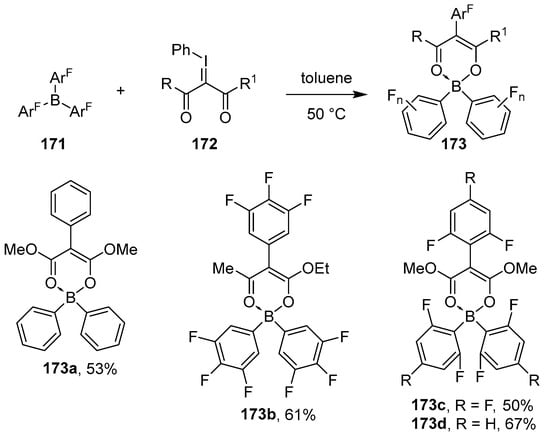
Scheme 58.
Carboboration of iodonium ylides 172.
4.2. Synthesis of Four-Coordinated Borinic Acids from Tetraarylborate Salts
The synthesis of bicyclic oxazaborinines 176 has been described starting from cyclic β-enaminones 175, bearing a secondary amino group, and benzenediazonium tetraphenylborates 174 (Scheme 59) [180,181]. The corresponding oxazaborinines 176 were obtained in modest to good yields, depending on the nature of the 4-substituted benzenediazonium and the size of the cyclic enaminones 175. Some related examples were also described starting from β-enaminoamides [182] and β-enaminonitriles [183].
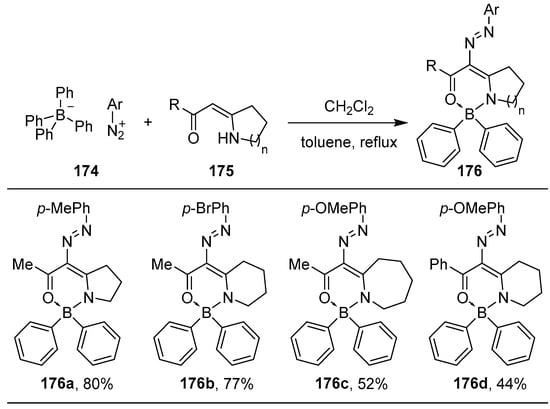
Scheme 59.
Synthesis of oxazaborinines 176 from benzenediazonium tetraphenylborates 174.
In the proposed mechanism, the initial addition of the enamine 175 onto the diazonium salt 174 leads to the intermediate 177, which undergoes a protodeboronation process giving rise to triarylborane (Scheme 60) [134]. The latter then reacts with the enaminone 178 to form the oxazaborinine 176.

Scheme 60.
Proposed mechanism for the formation of 176.
An alternative method for the preparation of oxazaborolidinones 181 has been developed by Candeais et al. from tetraarylborates 180, prepared by the addition of the corresponding Grignard reagents of 179 onto sodium tetrafluoroborate (Scheme 61) [184]. Condensation of the ammonium salts with L-valine in refluxing toluene produced oxazaborolidinones 181. Although the yields are modest, the reaction tolerates EDG and EWG on the aromatic ring. Some of these compounds showed moderate antitumor activity against colorectal adenocarcinoma cells and human brain astrocytoma cells.
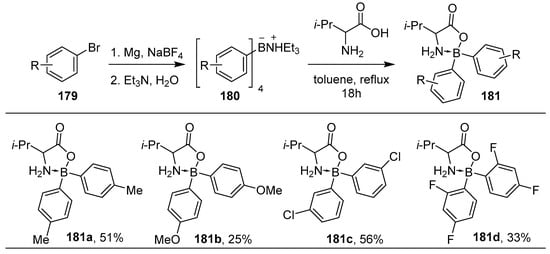
Scheme 61.
Synthesis of oxazaborolidinones 181.
Tetraarylborate salts have also been used in the efficient synthesis of fluorescent N,N′-chelate organoboron aminoquinolates [185]. It was shown that iodine is able to catalyze the reaction of tetraarylborates 182 with a variety of aminoquinolates 183 in refluxing toluene (Scheme 62). The reaction was exemplified on 20 substrates, with good to excellent yields obtained when R2 is an electron-withdrawing group (i.e., CF3, C2F5, 184a–d). Furthermore, the substitution on the aminoquinolate (i.e., 184b) and the aryl group (i.e., 184c–d) is also well tolerated.
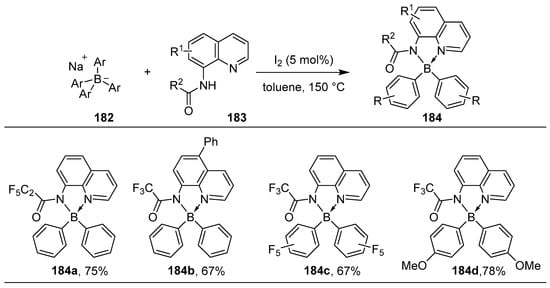
Scheme 62.
Synthesis of N,N′-chelate organoboron aminoquinolates 184 catalyzed by iodine.
After a series of control experiments, the authors proposed the mechanism depicted in Scheme 63, involving a radical pathway. First, the iodine radical formed by homolytic cleavage, oxidizes Ar4BNa 182 to produce the intermediate Ar4B• radical. The latter then reacts with the aminoquinoline 183 to give the desired product 184, ArH and an aryl radical. A final reduction (SET) from 182 to Ar• leads to ArNa and regenerates the Ar4B• radical.
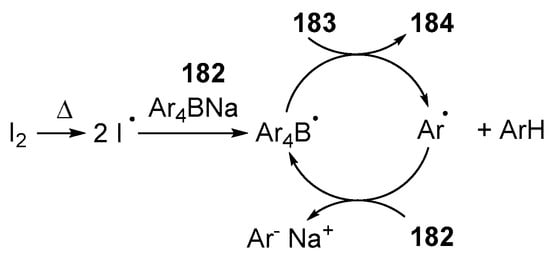
Scheme 63.
Proposed mechanism for the iodine-catalyzed synthesis of organoborons 184.
4.3. Synthesis of Borinic Acids by Hydrolysis or Oxidation of Triaryl Boranes
The hydrolysis and oxidation of triarylboranes has been described in few examples and is limited to specific substrates. For instance, the synthesis of perfluorinated borinic acid 188 was reported following two complementary methods (Scheme 64) [186]. Triarylborane 187 was either synthesized by the addition of ArFLi or ArFMgBr onto PhBCl2 or PhBF3K, respectively. Selective hydrolysis of 187 with one equivalent of water furnished the corresponding borinic acid 188 with 27% and 46% yields depending on the strategy.

Scheme 64.
Synthesis of perfluorinated borinic acid 188.
Other examples are related to the study of the reactivity of sterically hindered triarylboranes towards water (Scheme 65). During their study on frustrated Lewis pairs, Gras and coworkers reported that the crystallization of 190 in heptane led to the formation of borinic acid 191 with a 48% yield, as a result of the partial protodeboronation of 190 [187]. A related reactivity was also observed by Gabbaï et al. with the air-stable bis(dimesitylborane) 193 [188]. Its treatment with TASF (tris(dimethylamino)sulfonium difluorotrimethylsilicate) followed by an aqueous solution of Al(NO3)3 gave the air- and moisture-stable borinic acid 194 with a 70% yield. It was presumed that the formation of 194 occurred by hydrolysis of the C–B bond promoted by a fluoride ion. A selective C–B bond hydrolysis of 9-borafluorene 196 has also been described by Wehmschulte [189]. They found that prolonged treatment (1 week) of pyridine complex 196 in the presence of concentrated aqueous HCl and air led to sterically hindered diarylborinic acid 197 with a 17% yield after crystallization.
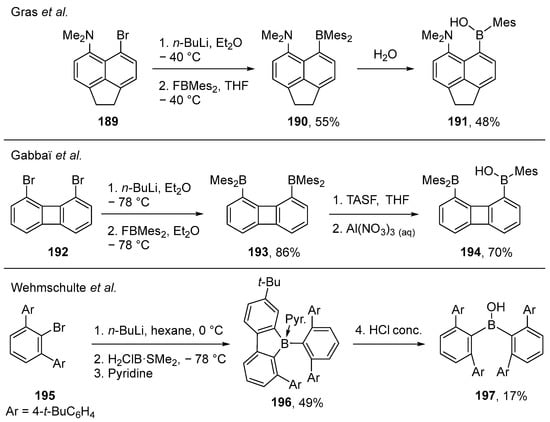
Scheme 65.
Examples of hydrolysis of triarylboranes [187,188,189].
It should be noted that oxidation of triarylboranes into borinic acids has been reported under air or oxygen, but the reactions are limited to specific substrates [57,190]. Furthermore, the oxidation of NaBArF4 into the corresponding borinic acid has also been observed (~15% yield) in the presence of an equimolar quantity of ReO3Cl complex [191].
5. Conclusions
This review summarized the main approaches to access borinic acids, and their chelate derivatives. These methods have been successfully applied to the synthesis of symmetrical and non-symmetrical borinic acids, including boron-containing heterocycles. Many of these organoboron compounds have found applications in organic light emitting diodes (OLEDs), medicinal chemistry, catalysis, material sciences, etc. However, there are still some synthetic challenges that need to be addressed. In particular, most of the syntheses rely on the addition of organometallic species (ArLi, ArMgX) onto electrophilic boron reagents. Although several advances have been made to selectively prepare borinic acids (without the formation of boronic acids and/or triarylboranes), these methods still suffer from a lack of functional group compatibility with the organometallics. Metal-catalyzed strategies have recently emerged to answer this issue but are limited to specific substrates (i.e., cyclic borinic acids), or result in low isolated yields in the case of acyclic borinic acids. The selective synthesis of non-symmetrical borinic acids, especially in the acyclic series, is another major challenge. Except for some isolated examples, there are no functional-group-tolerant and general methods to tackle this issue. The development of such approaches should have a significant impact in the field, allowing the access to new organoboron structures with unexplored properties. Table 1 summarizes the main boron reagents and methods used for the synthesis of borinic acid derivatives, with their advantages and limitations.

Table 1.
Advantages and limitations of the main boron reagents and methods.
Author Contributions
Conceptualization, L.C. and M.P.; writing—original draft preparation, L.C.; writing—review and editing, M.B., L.C. and M.P.; visualization, M.B., L.C. and M.P.; supervision, L.C. and M.P.; project administration, L.C. and M.P. All authors have read and agreed to the published version of the manuscript.
Funding
The authors are grateful to the University of Bordeaux, CNRS and ANR (ANR-18-CE07-0046), for financial support.
Institutional Review Board Statement
Not applicable.
Informed Consent Statement
Not applicable.
Data Availability Statement
Not applicable.
Conflicts of Interest
The authors declare no conflict of interest.
References
- Hiller, N.d.J.; do Amaral e Silva, N.A.; Tavares, T.A.; Faria, R.X.; Eberlin, M.N.; de Luna Martins, D. Arylboronic Acids and their Myriad of Applications Beyond Organic Synthesis. Eur. J. Org. Chem. 2020, 2020, 4841–4877. [Google Scholar] [CrossRef]
- Flores-Parra, A.; Contreras, R. Boron coordination compounds derived from organic molecules of biological interest. Coord. Chem. Rev. 2000, 196, 85–124. [Google Scholar] [CrossRef]
- Beringhelli, T.; D’Alfonso, G.; Donghi, D.; Maggioni, D.; Mercandelli, P.; Sironi, A. Aggregation and Ionization Equilibria of Bis(pentafluorophenyl)borinic Acid Driven by Hydrogen-Bonding with Tetrahydrofuran. Organometallics 2007, 26, 2088–2095. [Google Scholar] [CrossRef]
- Donghi, D.; Maggioni, D.; Beringhelli, T.; D’Alfonso, G.; Mercandelli, P.; Sironi, A. Hydrogen Bonding and Lewis Acid–Base Interactions in the System Bis(pentafluorophenyl)borinic Acid / Methanol. Eur. J. Inorg. Chem. 2008, 2008, 1645–1653. [Google Scholar] [CrossRef]
- Donghi, D.; Maggioni, D.; Beringhelli, T.; D’Alfonso, G. 19 F NMR Spectroscopic Investigation of the Reaction of Bis(pentafluorophenyl)borinic Acid with a “Proton Sponge”: Deprotonation, Trimerization and Stepwise Dearylation. Eur. J. Inorg. Chem. 2008, 2008, 3606–3613. [Google Scholar] [CrossRef]
- Chen, X.; Ke, H.; Zou, G. Nickel-Catalyzed Cross-Coupling of Diarylborinic Acids with Aryl Chlorides. ACS Catal. 2014, 4, 379–385. [Google Scholar] [CrossRef]
- Chen, X.; Ke, H.; Chen, Y.; Guan, C.; Zou, G. Cross-coupling of diarylborinic acids and anhydrides with arylhalides catalyzed by a phosphite/N-heterocyclic carbene co-supported palladium catalyst system. J. Org. Chem. 2012, 77, 7572–7578. [Google Scholar] [CrossRef]
- Hofer, A.; Kovacs, G.; Zappatini, A.; Leuenberger, M.; Hediger, M.A.; Lochner, M. Design, synthesis and pharmacological characterization of analogs of 2-aminoethyl diphenylborinate (2-APB), a known store-operated calcium channel blocker, for inhibition of TRPV6-mediated calcium transport. Bioorg. Med. Chem. 2013, 21, 3202–3213. [Google Scholar] [CrossRef]
- Dellis, O.; Mercier, P.; Chomienne, C. The boron-oxygen core of borinate esters is responsible for the store-operated calcium entry potentiation ability. BMC Pharmacol. 2011, 11, 1. [Google Scholar] [CrossRef]
- Suzuki, A.Z.; Ozaki, S.; Goto, J.; Mikoshiba, K. Synthesis of bisboron compounds and their strong inhibitory activity on store-operated calcium entry. Bioorg. Med. Chem. Lett. 2010, 20, 1395–1398. [Google Scholar] [CrossRef]
- Haque, A.; Al-Balushi, R.A.; Raithby, P.R.; Khan, M.S. Recent Advances in π-Conjugated N^C-Chelate Organoboron Materials. Molecules 2020, 25, 2645. [Google Scholar] [CrossRef] [PubMed]
- Taylor, M.S. Catalysis Based on Reversible Covalent Interactions of Organoboron Compounds. Acc. Chem. Res. 2014, 48, 295–305. [Google Scholar] [CrossRef] [PubMed]
- Kobayashi, Y.; Takemoto, Y. Regio- and stereoselective glycosylation of 1,2-O-unprotected sugars using organoboron catalysts. Tetrahedron 2020, 76, 131328. [Google Scholar] [CrossRef]
- Li, D.; Zhang, H.; Wang, Y. Four-coordinate organoboron compounds for organic light-emitting diodes (OLEDs). Chem. Soc. Rev. 2013, 42, 8416–8433. [Google Scholar] [CrossRef] [PubMed]
- Guan, C.; Huang, L.; Ren, C.; Zou, G. Development of a Telescoped Process for Preparation of N,O-Chelated Diarylborinates. Org. Process Res. Dev. 2018, 22, 824–828. [Google Scholar] [CrossRef]
- Hessel, V.; Hofmann, C.; Löwe, H.; Meudt, A.; Scherer, S.; Schönfeld, F.; Werner, B. Selectivity Gains and Energy Savings for the Industrial Phenyl Boronic Acid Process Using Micromixer/Tubular Reactors. Org. Process Res. Dev. 2004, 8, 511–523. [Google Scholar] [CrossRef]
- Baldwin, A.G.; Tapia, V.S.; Swanton, T.; White, C.S.; Beswick, J.A.; Brough, D.; Freeman, S. Design, Synthesis and Evaluation of Oxazaborine Inhibitors of the NLRP3 Inflammasome. ChemMedChem 2018, 13, 312–320. [Google Scholar] [CrossRef]
- Wang, M.; Nudelman, F.; Matthes, R.R.; Shaver, M.P. Frustrated Lewis Pair Polymers as Responsive Self-Healing Gels. J. Am. Chem. Soc. 2017, 139, 14232–14236. [Google Scholar] [CrossRef]
- Povlock, T.P.; Lippincott, W.T. The Reaction of Trimethoxyboroxine with Aromatic Grignard Reagents: A New Synthesis of Borinic Acids1. J. Am. Chem. Soc. 1958, 80, 5409–5411. [Google Scholar] [CrossRef]
- Murakami, S.; Suzuki, T. Method for Producing Borinic Acid Derivative, and Novel Borinic Acid Derivative. WO2014030600, 2014. [Google Scholar]
- Hawkins, V.F.; Wilkinson, M.C.; Whiting, M. Mild and Selective Synthesis of an Aryl Boronic Ester by Equilibration of Mixtures of Boronic and Borinic Acid Derivatives. Org. Process Res. Dev. 2008, 12, 1265–1268. [Google Scholar] [CrossRef]
- Bell, B.M.; Clark, T.P.; De Vries, T.S.; Lai, Y.; Laitar, D.S.; Gallagher, T.J.; Jeon, J.-H.; Kearns, K.L.; McIntire, T.; Mukhopadhyay, S.; et al. Boron-based TADF emitters with improved OLED device efficiency roll-off and long lifetime. Dyes Pigm. 2017, 141, 83–92. [Google Scholar] [CrossRef]
- Davidson, J.M.; French, C.M. The synthesis and structure of aromatic boron compounds. J. Chem. Soc. 1960, 191–195. [Google Scholar] [CrossRef]
- El Dine, T.M.; Rouden, J.; Blanchet, J. Borinic acid catalysed peptide synthesis. Chem. Commun. 2015, 51, 16084–16087. [Google Scholar] [CrossRef]
- Baker, S.J.; Akama, T.; Zhang, Y.K.; Sauro, V.; Pandit, C.; Singh, R.; Kully, M.; Khan, J.; Plattner, J.J.; Benkovic, S.J.; et al. Identification of a novel boron-containing antibacterial agent (AN0128) with anti-inflammatory activity, for the potential treatment of cutaneous diseases. Bioorg. Med. Chem. Lett. 2006, 16, 5963–5967. [Google Scholar] [CrossRef]
- Ke, H.; Chen, X.; Zou, G. N-Heterocyclic Carbene-Assisted, Bis(phosphine)nickel-Catalyzed Cross-Couplings of Diarylborinic Acids with Aryl Chlorides, Tosylates, and Sulfamates. J. Org. Chem. 2014, 79, 7132–7140. [Google Scholar] [CrossRef] [PubMed]
- Torabi Kohlbouni, S.; Sarkar, A.; Zhang, J.; Li, X.; Borhan, B. Absolute stereochemical determination of 1,2-diols via complexation with dinaphthyl borinic acid. Chirality 2020, 32, 817–823. [Google Scholar] [CrossRef]
- Sengupta, A.; Doshi, A.; Jäkle, F.; Peetz, R.M. Segmented conjugated macromolecules containing silicon and boron: ADMET synthesis and luminescent properties. J. Polym. Sci. Pol. Chem. 2015, 53, 1707–1718. [Google Scholar] [CrossRef]
- Wan, W.-M.; Li, S.-S.; Liu, D.-M.; Lv, X.-H.; Sun, X.-L. Synthesis of Electron-Deficient Borinic Acid Polymers with Multiresponsive Properties and Their Application in the Fluorescence Detection of Alizarin Red S and Electron-Rich 8-Hydroxyquinoline and Fluoride Ion: Substituent Effects. Macromolecules 2017, 50, 6872–6879. [Google Scholar] [CrossRef]
- Lv, X.-H.; Li, S.-S.; Tian, C.-Y.; Yang, M.-M.; Li, C.; Zhou, Y.; Sun, X.-L.; Zhang, J.; Wan, W.-M. Borinic Acid Polymer: Simplified Synthesis and Enzymatic Biofuel Cell Application. Macromol. Rapid Commun. 2017, 38, 1600687. [Google Scholar] [CrossRef]
- Wang, G.; Taylor, M.S. Borinic Acid-Catalyzed Regioselective Ring-Opening of 3,4- and 2,3-Epoxy Alcohols with Halides. Adv. Synth. Catal. 2020, 362, 398–403. [Google Scholar] [CrossRef]
- Cheung, K.Y.; Miao, Q. A ketone-functionalized aromatic saddle as a potential building block for negatively curved carbon nanobelts. Chin. Chem. Lett. 2019, 30, 1506–1508. [Google Scholar] [CrossRef]
- Igarashi, T.; Tobisu, M.; Chatani, N. Catalytic Double Carbon-Boron Bond Formation for the Synthesis of Cyclic Diarylborinic Acids as Versatile Building Blocks for pi-Extended Heteroarenes. Angew. Chem. Int. Ed. 2017, 56, 2069–2073. [Google Scholar] [CrossRef] [PubMed]
- Zhou, X.; Lesiak, L.; Lai, R.; Beck, J.R.; Zhao, J.; Elowsky, C.G.; Li, H.; Stains, C.I. Chemoselective Alteration of Fluorophore Scaffolds as a Strategy for the Development of Ratiometric Chemodosimeters. Angew. Chem. Int. Ed. 2017, 56, 4197–4200. [Google Scholar] [CrossRef] [PubMed]
- Lee, H.; Cha, I.; Lee, E.J.; Lee, Y.; Kim, Y.H.; Song, C. Annulated Borepin-1-ol: Coordinative Control of Aromaticity and Photophysical Properties. Chem. Lett. 2014, 43, 1432–1434. [Google Scholar] [CrossRef]
- Dimitrijević, E.; Taylor, M.S. 9-Hetero-10-boraanthracene-derived borinic acid catalysts for regioselective activation of polyols. Chem. Sci. 2013, 4, 3298–3303. [Google Scholar] [CrossRef]
- Dimitrijevic, E.; Cusimano, M.; Taylor, M.S. Synthesis of benzannulated heterocycles by twofold Suzuki-Miyaura couplings of cyclic diarylborinic acids. Org. Biomol. Chem. 2014, 12, 1391–1394. [Google Scholar] [CrossRef]
- Agou, T.; Sekine, M.; Kawashima, T. Stepwise synthesis and properties of a 9,10-dihydro-9,10-diboraanthracene. Tetrahedron Lett. 2010, 51, 5013–5015. [Google Scholar] [CrossRef]
- Niu, L.; Yang, H.; Jiang, Y.; Fu, H. Efficient Synthesis of Dibenzoxaborininols from Diaryl Ethers and Their Application to Dibenzofuran Synthesis. Adv. Synth. Catal. 2013, 355, 3625–3632. [Google Scholar] [CrossRef]
- Hirano, K.; Morimoto, K.; Fujioka, S.; Miyamoto, K.; Muranaka, A.; Uchiyama, M. Nucleophilic Diboration Strategy Targeting Diversified 1-Boraphenarene Architectures. Angew. Chem. Int. Ed. 2020, 59, 21448–21453. [Google Scholar] [CrossRef]
- Gibson, V.C.; Redshaw, C.; Clegg, W.; Elsegood, M.R.J. Synthesis and structural characterization of some novel metalloboroxides bearing boron-bound mesityl and fluoromesityl substituents: The molecular structure of the first metallaboroxane complex. Polyhedron 1997, 16, 2637–2641. [Google Scholar] [CrossRef]
- Cornet, S.M.; Dillon, K.B.; Entwistle, C.D.; Fox, M.A.; Goeta, A.E.; Goodwin, H.P.; Marder, T.B.; Thompson, A.L. Synthesis and characterisation of some new boron compounds containing the 2,4,6-(CF3)3C6H2(fluoromes = Ar), 2,6-(CF3)2C6H3(fluoroxyl = Ar′), or 2,4-(CF3)2C6H3(Ar″) ligands. Dalton Trans. 2003, 23, 4395–4405. [Google Scholar] [CrossRef]
- Chazalette, C.; Riviere-Baudet, M.; Scozzafava, A.; Abbate, F.; Maarouf, Z.B.; Supuran, C.T. Carbonic Anhydrase Inhibitors, Interaction of Boron Derivatives with Isozymes I and II: A New Binding Site for Hydrophobic Inhibitors at the Entrance of the Active Site as shown by Docking Studies. J. Enzyme Inhib. 2010, 16, 125–133. [Google Scholar] [CrossRef]
- Ishikawa, Y.; Suzuki, K.; Hayashi, K.; Nema, S.-y.; Yamashita, M. Chlorine-Substituted 9,10-Dihydro-9-aza-10-boraanthracene as a Precursor for Various Boron- and Nitrogen-Containing π-Conjugated Compounds. Org. Lett. 2019, 21, 1722–1725. [Google Scholar] [CrossRef]
- Urban, M.; Durka, K.; Górka, P.; Wiosna-Sałyga, G.; Nawara, K.; Jankowski, P.; Luliński, S. The effect of locking π-conjugation in organoboron moieties in the structures of luminescent tetracoordinate boron complexes. Dalton Trans. 2019, 48, 8642–8663. [Google Scholar] [CrossRef]
- Shoji, Y.; Shigeno, N.; Takenouchi, K.; Sugimoto, M.; Fukushima, T. Mechanistic Study of Highly Efficient Direct 1,2-Carboboration of Alkynes with 9-Borafluorenes. Chem. Eur. J. 2018, 24, 13223–13230. [Google Scholar] [CrossRef] [PubMed]
- Venkatasubbaiah, K.; Pakkirisamy, T.; Lalancette, R.A.; Jäkle, F. Tuning the electronic structure of diboradiferrocenes. Dalton Trans. 2008, 33, 4507–4513. [Google Scholar] [CrossRef] [PubMed]
- Thilagar, P.; Murillo, D.; Chen, J.; Jakle, F. Synthesis and supramolecular assembly of the bifunctional borinic acid [1,2-fcB(OH)]2. Dalton Trans. 2013, 42, 665–670. [Google Scholar] [CrossRef]
- Coates, G.E.; Livingstone, J.G. 965. Aminoditolylborane and the preparation of diarylborinic acids. J. Chem. Soc. 1961, 4909–4911. [Google Scholar] [CrossRef]
- Marciasini, L.; Cacciuttolo, B.; Vaultier, M.; Pucheault, M. Synthesis of Borinic Acids and Borinate Adducts Using Diisopropylaminoborane. Org. Lett. 2015, 17, 3532–3535. [Google Scholar] [CrossRef]
- Qi, Y.; Xu, W.; Kang, R.; Ding, N.; Wang, Y.; He, G.; Fang, Y. Discrimination of saturated alkanes and relevant volatile compounds via the utilization of a conceptual fluorescent sensor array based on organoboron-containing polymers. Chem. Sci. 2018, 9, 1892–1901. [Google Scholar] [CrossRef]
- Pucheault, M.; Pinet, S.; Richard, J.; Birepinte, M.; Charbonnier, J.; Liautard, V. Borinic Acids via Direct Arylation of Amine–Borane Complexes: An Air- and Water-Stable Boron Source. Synthesis 2017, 49, 736–744. [Google Scholar] [CrossRef]
- Guerrand, H.D.S.; Marciasini, L.D.; Jousseaume, M.; Vaultier, M.; Pucheault, M. Borylation of Unactivated Aryl Chlorides under Mild Conditions by Using Diisopropylaminoborane as a Borylating Reagent. Chem. Eur. J. 2014, 20, 5573–5579. [Google Scholar] [CrossRef] [PubMed]
- Shimazumi, R.; Igarashi, T.; Tobisu, M. Palladium-catalyzed B-Diarylation of Diethylaminoborane for the Synthesis of Diarylborinic Acids. Chem. Lett. 2020, 49, 760–763. [Google Scholar] [CrossRef]
- Pickles, G.M.; Spencer, T.; Thorpe, F.G.; Chopa, A.B.; Podesta, J.C. The reactions of diborane with aryl-organotin compounds. J. Organomet. Chem. 1984, 260, 7–15. [Google Scholar] [CrossRef]
- Kirschner, S.; Mewes, J.-M.; Bolte, M.; Lerner, H.-W.; Dreuw, A.; Wagner, M. How Boron Doping Shapes the Optoelectronic Properties of Canonical and Phenylene-Containing Oligoacenes: A Combined Experimental and Theoretical Investigation. Chem. Eur. J. 2017, 23, 5104–5116. [Google Scholar] [CrossRef]
- Kirschner, S.; Bao, S.-S.; Fengel, M.K.; Bolte, M.; Lerner, H.-W.; Wagner, M. Aryl–aryl coupling in a polycyclic aromatic hydrocarbon with embedded tetracoordinate boron centre. Org. Biomol. Chem. 2019, 17, 5060–5065. [Google Scholar] [CrossRef]
- Yuan, K.; Wang, X.; Mellerup, S.K.; Kozin, I.; Wang, S. Spiro-BODIPYs with a Diaryl Chelate: Impact on Aggregation and Luminescence. J. Org. Chem. 2017, 82, 13481–13487. [Google Scholar] [CrossRef]
- Sole, S.; Gabbai, F.P. A bidentate borane as colorimetric fluoride ion sensor. Chem. Commun. 2004, 11, 1284–1285. [Google Scholar] [CrossRef]
- Shigemori, K.; Watanabe, M.; Kong, J.; Mitsudo, K.; Wakamiya, A.; Mandai, H.; Suga, S. Iodide-Mediated or Iodide-Catalyzed Demethylation and Friedel-Crafts C-H Borylative Cyclization Leading to Thiophene-Fused 1,2-Oxaborine Derivatives. Org. Lett. 2019, 21, 2171–2175. [Google Scholar] [CrossRef]
- Matsui, K.; Oda, S.; Yoshiura, K.; Nakajima, K.; Yasuda, N.; Hatakeyama, T. One-Shot Multiple Borylation toward BN-Doped Nanographenes. J. Am. Chem. Soc. 2018, 140, 1195–1198. [Google Scholar] [CrossRef]
- Suresh, S.M.; Duda, E.; Hall, D.; Yao, Z.; Bagnich, S.; Slawin, A.M.Z.; Bassler, H.; Beljonne, D.; Buck, M.; Olivier, Y.; et al. A Deep Blue B,N-Doped Heptacene Emitter That Shows Both Thermally Activated Delayed Fluorescence and Delayed Fluorescence by Triplet-Triplet Annihilation. J. Am. Chem. Soc. 2020, 142, 6588–6599. [Google Scholar] [CrossRef]
- Kahan, R.J.; Crossley, D.L.; Cid, J.; Radcliffe, J.E.; Ingleson, M.J. Synthesis, Characterization, and Functionalization of 1-Boraphenalenes. Angew. Chem. Int. Ed. 2018, 57, 8084–8088. [Google Scholar] [CrossRef]
- Yuan, K.; Kahan, R.J.; Si, C.; Williams, A.; Kirschner, S.; Uzelac, M.; Zysman-Colman, E.; Ingleson, M.J. The synthesis of brominated-boron-doped PAHs by alkyne 1,1-bromoboration: Mechanistic and functionalisation studies. Chem. Sci. 2020, 11, 3258–3267. [Google Scholar] [CrossRef]
- Curran, D.P.; Solovyev, A.; Makhlouf Brahmi, M.; Fensterbank, L.; Malacria, M.; Lacôte, E. Synthesis and Reactions of N-Heterocyclic Carbene Boranes. Angew. Chem. Int. Ed. 2011, 50, 10294–10317. [Google Scholar] [CrossRef]
- Farrell, J.M.; Stephan, D.W. Planar N-Heterocyclic Carbene Diarylborenium Ions: Synthesis by Cationic Borylation and Reactivity with Lewis Bases. Angew. Chem. Int. Ed. 2015, 54, 5214–5217. [Google Scholar] [CrossRef]
- Schnitzlein, M.; Zhu, C.; Shoyama, K.; Würthner, F. π-Extended Pleiadienes by [5+2] Annulation of 1-Boraphenalenes and ortho-Dihaloarenes. Chem. Eur. J. 2022, 28, e202202053. [Google Scholar] [CrossRef]
- Farrell, J.M.; Schmidt, D.; Grande, V.; Wurthner, F. Synthesis of a Doubly Boron-Doped Perylene through NHC-Borenium Hydroboration/C-H Borylation/Dehydrogenation. Angew. Chem. Int. Ed. 2017, 56, 11846–11850. [Google Scholar] [CrossRef] [PubMed]
- Farrell, J.M.; Mutzel, C.; Bialas, D.; Rudolf, M.; Menekse, K.; Krause, A.M.; Stolte, M.; Wurthner, F. Tunable Low-LUMO Boron-Doped Polycyclic Aromatic Hydrocarbons by General One-Pot C-H Borylations. J. Am. Chem. Soc. 2019, 141, 9096–9104. [Google Scholar] [CrossRef] [PubMed]
- Schnitzlein, M.; Mützel, C.; Shoyama, K.; Farrell, J.M.; Würthner, F. PAHs Containing both Heptagon and Pentagon: Corannulene Extension by [5+2] Annulation. Eur. J. Org. Chem. 2021, 2022, e202101273. [Google Scholar] [CrossRef]
- Zheng, Y.; Wang, X.; Bai, Y.; Wang, X.; Ru, C.; Chen, W.; Lv, X.; Pan, X.; Wu, J. Diradical Anion of Potassium Aggregate: Reduction of Dimer Boroxide Complex. Inorg. Chem. 2018, 57, 13544–13551. [Google Scholar] [CrossRef]
- Albrecht, K.; Kaiser, V.; Boese, R.; Adams, J.; Kaufmann, D.E. Synthesis and properties of fluorescent organoboranes: Triarylmethane-type dyes. J. Chem. Soc. Perkin Trans. 2 2000, 10, 2153–2157. [Google Scholar] [CrossRef]
- Wesela-Bauman, G.; Ciecwierz, P.; Durka, K.; Lulinski, S.; Serwatowski, J.; Woźniak, K. Heteroleptic (2-fluoro-3-pyridyl)arylborinic 8-oxyquinolinates for the potential application in organic light-emitting devices. Inorg. Chem. 2013, 52, 10846–10859. [Google Scholar] [CrossRef] [PubMed]
- Urban, M.; Durka, K.; Kasprzak, A.; Klis, T.; Monkman, A.P.; Piszcz, M.; Woźniak, K. Excited-state photodynamics of pyrene-containing boronated dyes. Dyes Pigm. 2022, 197, 109934. [Google Scholar] [CrossRef]
- Wan, W.-M.; Cheng, F.; Jäkle, F. A Borinic Acid Polymer with Fluoride Ion- and Thermo-responsive Properties that are Tunable over a Wide Temperature Range. Angew. Chem. Int. Ed. 2014, 53, 8934–8938. [Google Scholar] [CrossRef] [PubMed]
- Gatin-Fraudet, B.; Ottenwelter, R.; Le Saux, T.; Norsikian, S.; Pucher, M.; Lombès, T.; Baron, A.; Durand, P.; Doisneau, G.; Bourdreux, Y.; et al. Evaluation of borinic acids as new, fast hydrogen peroxide–responsive triggers. Proc. Natl. Acad. Sci. USA 2021, 118, e2107503118. [Google Scholar] [CrossRef]
- Wesela-Bauman, G.; Jastrzębski, L.; Kurach, P.; Luliński, S.; Serwatowski, J.; Woźniak, K. Synthesis of functionalized diarylborinic 8-oxyquinolates via bimetallic boron–lithium intermediates. J. Organomet. Chem. 2012, 711, 1–9. [Google Scholar] [CrossRef]
- Luliński, S.; Smętek, J.; Durka, K.; Serwatowski, J. Tandem Synthesis of 9,10-Dihydro-9,10-diboraanthracenes via Elusiveortho-Lithiated Phenylboronates. Eur. J. Org. Chem. 2013, 2013, 8315–8322. [Google Scholar] [CrossRef]
- Brend’amour, S.; Gilmer, J.; Bolte, M.; Lerner, H.W.; Wagner, M. C-Halogenated 9,10-Diboraanthracenes: How the Halogen Load and Distribution Influences Key Optoelectronic Properties. Chem. Eur. J. 2018, 24, 16910–16918. [Google Scholar] [CrossRef]
- Kaehler, T.; Bolte, M.; Lerner, H.W.; Wagner, M. Introducing Perylene as a New Member to the Azaborine Family. Angew. Chem. Int. Ed. 2019, 58, 11379–11384. [Google Scholar] [CrossRef]
- Körner, C.; Starkov, P.; Sheppard, T.D. An Alternative Approach to Aldol Reactions: Gold-Catalyzed Formation of Boron Enolates from Alkynes. J. Am. Chem. Soc. 2010, 132, 5968–5969. [Google Scholar] [CrossRef]
- Ouadoudi, O.; Kaehler, T.; Bolte, M.; Lerner, H.-W.; Wagner, M. One tool to bring them all: Au-catalyzed synthesis of B,O- and B,N-doped PAHs from boronic and borinic acids. Chem. Sci. 2021, 12, 5898–5909. [Google Scholar] [CrossRef] [PubMed]
- Brosge, F.; Lorenz, T.; Helten, H.; Bolm, C. BN- and BO-Doped Inorganic-Organic Hybrid Polymers with Sulfoximine Core Units. Chem. Eur. J. 2019, 25, 12708–12711. [Google Scholar] [CrossRef] [PubMed]
- Lorenz, T.; Crumbach, M.; Eckert, T.; Lik, A.; Helten, H. Poly(p-phenylene iminoborane): A Boron-Nitrogen Analogue of Poly(p-phenylene vinylene). Angew. Chem. Int. Ed. 2017, 56, 2780–2784. [Google Scholar] [CrossRef] [PubMed]
- Budanow, A.; von Grotthuss, E.; Bolte, M.; Wagner, M.; Lerner, H.-W. 10,9-Oxaboraphenanthrenes as luminescent fluorophores. Tetrahedron 2016, 72, 1477–1484. [Google Scholar] [CrossRef]
- Xu, S.; Haeffner, F.; Li, B.; Zakharov, L.N.; Liu, S.Y. Monobenzofused 1,4-azaborines: Synthesis, characterization, and discovery of a unique coordination mode. Angew. Chem. Int. Ed. 2014, 53, 6795–6799. [Google Scholar] [CrossRef] [PubMed]
- van Veen, R.; Bickelhaupt, F. Synthesis of the 9-mesityl-10-phenyl-9-boraanthracene anion. J. Organomet. Chem. 1972, 43, 241–248. [Google Scholar] [CrossRef]
- Van Veen, R.; Bickelhaupt, F. Synthesis of 5-and 6-membered carbon-boron heterocycles by pyrolysis of pyridine-arylboranes. J. Organomet. Chem. 1973, 47, 33–38. [Google Scholar] [CrossRef]
- You, C.; Sakai, M.; Daniliuc, C.G.; Bergander, K.; Yamaguchi, S.; Studer, A. Regio- and Stereoselective 1,2-Carboboration of Ynamides with Aryldichloroboranes. Angew. Chem. Int. Ed. 2021, 60, 21697–21701. [Google Scholar] [CrossRef]
- Baraniak, M.K.; Lalancette, R.A.; Jakle, F. Electron-Deficient Borinic Acid Polymers: Synthesis, Supramolecular Assembly, and Examination as Catalysts in Amide Bond Formation. Chem. Eur. J. 2019, 25, 13799–13810. [Google Scholar] [CrossRef]
- Cheng, F.; Jakle, F. RAFT polymerization of luminescent boron quinolate monomers. Chem. Commun. 2010, 46, 3717–3719. [Google Scholar] [CrossRef]
- Qin, Y.; Kiburu, I.; Shah, S.; Jakle, F. Luminescence tuning of organoboron quinolates through substituent variation at the 5-position of the quinolato moiety. Org. Lett. 2006, 8, 5227–5230. [Google Scholar] [CrossRef] [PubMed]
- Sadu, V.S.; Bin, H.R.; Lee, D.M.; Lee, K.I. One-pot synthesis of four-coordinate boron(III) complexes by the ligand-promoted organic group migration between boronic acids. Sci. Rep. 2017, 7, 242. [Google Scholar] [CrossRef]
- Zu, W.; Day, C.; Wei, L.; Jia, X.; Xu, L. Dual aminoquinolate diarylboron and nickel catalysed metallaphotoredox platform for carbon-oxygen bond construction. Chem. Commun. 2020, 56, 8273–8276. [Google Scholar] [CrossRef] [PubMed]
- John, A.; Kirschner, S.; Fengel, M.K.; Bolte, M.; Lerner, H.-W.; Wagner, M. Simultaneous expansion of 9,10 boron-doped anthracene in longitudinal and lateral directions. Dalton Trans. 2019, 48, 1871–1877. [Google Scholar] [CrossRef] [PubMed]
- Seven, Ö.; Qu, Z.-W.; Zhu, H.; Bolte, M.; Lerner, H.-W.; Holthausen, M.C.; Wagner, M. Synthesis, Coupling, and Condensation Reactions of 1,2-Diborylated Benzenes: An Experimental and Quantum-Chemical Study. Chem. Eur. J. 2012, 18, 11284–11295. [Google Scholar] [CrossRef]
- Januszewski, E.; Lorbach, A.; Grewal, R.; Bolte, M.; Bats, J.W.; Lerner, H.W.; Wagner, M. Unsymmetrically substituted 9,10-dihydro-9,10-diboraanthracenes as versatile building blocks for boron-doped pi-conjugated systems. Chem. Eur. J. 2011, 17, 12696–12705. [Google Scholar] [CrossRef] [PubMed]
- Chinnapattu, M.; Sathiyanarayanan, K.I.; Iyer, P.S. Synthesis of benzofused 1,4-azaborinols via [4 + 2] annulation strategy and its application in indole synthesis. RSC Adv. 2015, 5, 37716–37720. [Google Scholar] [CrossRef]
- Shimomura, N.; Egawa, Y.; Miki, R.; Fujihara, T.; Ishimaru, Y.; Seki, T. A red fluorophore comprising a borinate-containing xanthene analogue as a polyol sensor. Org. Biomol. Chem. 2016, 14, 10031–10036. [Google Scholar] [CrossRef]
- Lyu, H.; Kevlishvili, I.; Yu, X.; Liu, P.; Dong, G. Boron insertion into alkyl ether bonds via zinc/nickel tandem catalysis. Science 2021, 372, 175–182. [Google Scholar] [CrossRef]
- Matsuda, T.; Sato, S. Synthesis of dibenzoheteropines of group 13-16 elements via ring-closing metathesis. J. Org. Chem. 2013, 78, 3329–3335. [Google Scholar] [CrossRef]
- Tokoro, Y.; Nagai, A.; Kokado, K.; Chujo, Y. Synthesis of Organoboron Quinoline-8-thiolate and Quinoline-8-selenolate Complexes and Their Incorporation into the π-Conjugated Polymer Main-Chain. Macromolecules 2009, 42, 2988–2993. [Google Scholar] [CrossRef]
- Cui, Y.; Liu, Q.D.; Bai, D.R.; Jia, W.L.; Tao, Y.; Wang, S. Organoboron compounds with an 8-hydroxyquinolato chelate and its derivatives: Substituent effects on structures and luminescence. Inorg. Chem. 2005, 44, 601–609. [Google Scholar] [CrossRef] [PubMed]
- Kappaun, S.; Rentenberger, S.; Pogantsch, A.; Zojer, E.; Mereiter, K.; Trimmel, G.; Saf, R.; Möller, K.C.; Stelzer, F.; Slugovc, C. Organoboron Quinolinolates with Extended Conjugated Chromophores: Synthesis, Structure, and Electronic and Electroluminescent Properties. Chem. Mater. 2006, 18, 3539–3547. [Google Scholar] [CrossRef]
- Cui, Y.; Wang, S. Diboron and triboron compounds based on linear and star-shaped conjugated ligands with 8-hydroxyquinolate functionality: Impact of intermolecular interaction and boron coordination on luminescence. J. Org. Chem. 2006, 71, 6485–6496. [Google Scholar] [CrossRef]
- Kim, N.G.; Shin, C.H.; Lee, M.H.; Do, Y. Four-coordinate boron compounds derived from 2-(2-pyridyl)phenol ligand as novel hole-blocking materials for phosphorescent OLEDs. J. Organomet. Chem. 2009, 694, 1922–1928. [Google Scholar] [CrossRef]
- Yan, Y.; Feng, P.; Zheng, Q.Z.; Liang, Y.F.; Lu, J.F.; Cui, Y.; Jiao, N. PdCl2 and N-hydroxyphthalimide co-catalyzed C(sp2)-H hydroxylation by dioxygen activation. Angew. Chem. Int. Ed. 2013, 52, 5827–5831. [Google Scholar] [CrossRef]
- Tokoro, Y.; Nagai, A.; Chujo, Y. Synthesis of π-Conjugated Polymers Containing Organoboron Benzo[h]quinolate in the Main Chain. Macromolecules 2010, 43, 6229–6233. [Google Scholar] [CrossRef]
- Qiu, F.; Zhang, N.; Tang, R.; Zhou, M.; Wang, Y.; Wei, W.; Bi, S.; Han, S.; Zhang, F. Asymmetric Boron-Cored Aggregation-Induced Emission Luminogen with Multiple Functions Synthesized through Stepwise Conversion from a Symmetric Ligand. J. Org. Chem. 2018, 83, 12977–12984. [Google Scholar] [CrossRef]
- Pais, V.F.; Ramirez-Lopez, P.; Romero-Arenas, A.; Collado, D.; Najera, F.; Perez-Inestrosa, E.; Fernandez, R.; Lassaletta, J.M.; Ros, A.; Pischel, U. Red-Emitting Tetracoordinate Organoboron Chelates: Synthesis, Photophysical Properties, and Fluorescence Microscopy. J. Org. Chem. 2016, 81, 9605–9611. [Google Scholar] [CrossRef]
- Massue, J.; Retailleau, P.; Ulrich, G.; Ziessel, R. Synthesis of luminescent BPh2-coordinated 2-(2′-hydroxyphenyl)benzoxazole (HBO). N. J. Chem. 2013, 37, 1224–1230. [Google Scholar] [CrossRef]
- Zhang, Z.; Zhang, H.; Jiao, C.; Ye, K.; Zhang, H.; Zhang, J.; Wang, Y. 2-(2-Hydroxyphenyl)benzimidazole-based four-coordinate boron-containing materials with highly efficient deep-blue photoluminescence and electroluminescence. Inorg. Chem. 2015, 54, 2652–2659. [Google Scholar] [CrossRef]
- Yagishita, F.; Kinouchi, T.; Hoshi, K.; Tezuka, Y.; Jibu, Y.; Karatsu, T.; Uemura, N.; Yoshida, Y.; Mino, T.; Sakamoto, M.; et al. Highly efficient blue emission from boron complexes of 1-(o-hydroxyphenyl)imidazo[1,5-a]pyridine. Tetrahedron 2018, 74, 3728–3733. [Google Scholar] [CrossRef]
- Li, D.; Wang, K.; Huang, S.; Qu, S.; Liu, X.; Zhu, Q.; Zhang, H.; Wang, Y. Brightly fluorescent red organic solids bearing boron-bridged π–conjugated skeletons. J. Mater. Chem. 2011, 21, 15298–15304. [Google Scholar] [CrossRef]
- Li, D.; Zhang, H.; Wang, C.; Huang, S.; Guo, J.; Wang, Y. Construction of full-color-tunable and strongly emissive materials by functionalizing a boron-chelate four-ring-fused π-conjugated core. J. Mater. Chem. 2012, 22, 4319–4328. [Google Scholar] [CrossRef]
- Benelhadj, K.; Massue, J.; Ulrich, G. 2,4 and 2,5-bis(benzooxazol-2′-yl)hydroquinone (DHBO) and their borate complexes: Synthesis and optical properties. New J. Chem. 2016, 40, 5877–5884. [Google Scholar] [CrossRef]
- Frath, D.; Azizi, S.; Ulrich, G.; Retailleau, P.; Ziessel, R. Facile synthesis of highly fluorescent Boranil complexes. Org. Lett. 2011, 13, 3414–3417. [Google Scholar] [CrossRef] [PubMed]
- Dobkowski, J.; Wnuk, P.; Buczynska, J.; Pszona, M.; Orzanowska, G.; Frath, D.; Ulrich, G.; Massue, J.; Mosquera-Vazquez, S.; Vauthey, E.; et al. Substituent and solvent effects on the excited state deactivation channels in anils and boranils. Chem. Eur. J. 2015, 21, 1312–1327. [Google Scholar] [CrossRef]
- Frath, D.; Benelhadj, K.; Munch, M.; Massue, J.; Ulrich, G. Polyanils and Polyboranils: Synthesis, Optical Properties, and Aggregation-Induced Emission. J. Org. Chem. 2016, 81, 9658–9668. [Google Scholar] [CrossRef]
- Wu, Y.; Li, Z.; Liu, Q.; Wang, X.; Yan, H.; Gong, S.; Liu, Z.; He, W. High solid-state luminescence in propeller-shaped AIE-active pyridine-ketoiminate-boron complexes. Org. Biomol. Chem. 2015, 13, 5775–5782. [Google Scholar] [CrossRef]
- Huang, J.; Wang, Y.; Van Hecke, K.; Pereshivko, O.P.; Peshkov, V.A. Studies on Functionalization of N,O-Chelated Isoquinoline-Enol Boron Complexes. Eur. J. Org. Chem. 2019, 2019, 2490–2497. [Google Scholar] [CrossRef]
- Zhang, H.; Hong, X.; Ba, X.; Yu, B.; Wen, X.; Wang, S.; Wang, X.; Liu, L.; Xiao, J. Synthesis, Physical Properties, and Photocurrent Behavior of Strongly Emissive Boron-Chelate Heterochrysene Derivatives. Asian J. Org. Chem. 2014, 3, 1168–1172. [Google Scholar] [CrossRef]
- Kubota, Y.; Kasatani, K.; Niwa, T.; Sato, H.; Funabiki, K.; Matsui, M. Synthesis and Fluorescence Properties of Pyrimidine-Based Diboron Complexes with Donor-pi-Acceptor Structures. Chem. Eur. J. 2016, 22, 1816–1824. [Google Scholar] [CrossRef] [PubMed]
- Kubota, Y.; Kasatani, K.; Takai, H.; Funabiki, K.; Matsui, M. Strategy to enhance solid-state fluorescence and aggregation-induced emission enhancement effect in pyrimidine boron complexes. Dalton Trans. 2015, 44, 3326–3341. [Google Scholar] [CrossRef] [PubMed]
- Kubota, Y.; Sakuma, Y.; Funabiki, K.; Matsui, M. Solvatochromic fluorescence properties of pyrazine-boron complex bearing a beta-iminoenolate ligand. J. Phys. Chem. A 2014, 118, 8717–8729. [Google Scholar] [CrossRef]
- Kubota, Y.; Hara, H.; Tanaka, S.; Funabiki, K.; Matsui, M. Synthesis and fluorescence properties of novel pyrazine-boron complexes bearing a beta-iminoketone ligand. Org. Lett. 2011, 13, 6544–6547. [Google Scholar] [CrossRef]
- Kubota, Y.; Tanaka, S.; Funabiki, K.; Matsui, M. Synthesis and fluorescence properties of thiazole-boron complexes bearing a beta-ketoiminate ligand. Org. Lett. 2012, 14, 4682–4685. [Google Scholar] [CrossRef]
- Gong, S.; Liu, Q.; Wang, X.; Xia, B.; Liu, Z.; He, W. AIE-active organoboron complexes with highly efficient solid-state luminescence and their application as gas sensitive materials. Dalton Trans. 2015, 44, 14063–14070. [Google Scholar] [CrossRef] [PubMed]
- Zhou, L.; Xu, D.; Gao, H.; Han, A.; Yang, Y.; Zhang, C.; Liu, X.; Zhao, F. Effects of cyano groups on the properties of thiazole-based β-ketoiminate boron complexes: Aggregation-induced emission and mechanofluorochromism. RSC Adv. 2016, 6, 69560–69568. [Google Scholar] [CrossRef]
- Kubota, Y.; Niwa, T.; Jin, J.; Funabiki, K.; Matsui, M. Synthesis, Absorption, and Electrochemical Properties of Quinoid-Type Bisboron Complexes with Highly Symmetrical Structures. Org. Lett. 2015, 17, 3174–3177. [Google Scholar] [CrossRef]
- Mikysek, T.; Kvapilová, H.; Doušová, H.; Josefík, F.; Šimůnek, P.; Růžičková, Z.; Ludvík, J. Synthesis, electrochemical, structural and theoretical study of new derivatives of OBN and OBO heterocycles. Inorg. Chim. Acta 2017, 455, 465–472. [Google Scholar] [CrossRef]
- Kunick, C.; Tolle, N.; Dunkel, U.; Oehninger, L.; Ott, I.; Preu, L.; Haase, T.; Behrends, S.; Jones, P.; Totzke, F.; et al. Synthesis and Structure of Fluorescent Chelate Boron Complexes of 4-Anilinomethylidene-1-benzazepine-2,5-dione Ligands. Synthesis 2011, 2011, 2848–2858. [Google Scholar] [CrossRef]
- Doušová, H.; Šimůnek, P.; Almonasy, N.; Růžičková, Z. Synthesis, NMR, X-ray and UV/Vis characterization and preliminary luminescence study of some boron β-iminoenolates having 6-aminocoumarin moiety. J. Organomet. Chem. 2016, 802, 60–71. [Google Scholar] [CrossRef]
- Pešková, M.; Šimůnek, P.; Bertolasi, V.; Macháček, V.; Lyčka, A. Novel 5-(4-Substituted-phenyldiazenyl)-1,3,2λ4-oxazaborines and Their Rearrangement to 1,2,4,3λ4-Triazaborines. Organometallics 2006, 25, 2025–2030. [Google Scholar] [CrossRef]
- González, A.; Granell, J.; Pinlella, J.F.; Alvarez-Larena, A. Boron complexes of L-cysteine. Tetrahedron 1998, 54, 13313–13322. [Google Scholar] [CrossRef]
- Gazis, T.A.; Dasgupta, A.; Hill, M.S.; Rawson, J.M.; Wirth, T.; Melen, R.L. Reactions of hydrazones and hydrazides with Lewis acidic boranes. Dalton Trans. 2019, 48, 12391–12395. [Google Scholar] [CrossRef] [PubMed]
- Rodrigues, A.I.; Figueira, C.A.; Gomes, C.S.B.; Suresh, D.; Ferreira, B.; Di Paolo, R.E.; Pereira, D.S.; Dias, F.B.; Calhorda, M.J.; Morgado, J.; et al. Boron complexes of aromatic 5-substituted iminopyrrolyl ligands: Synthesis, structure, and luminescence properties. Dalton Trans. 2019, 48, 13337–13352. [Google Scholar] [CrossRef]
- Krishnamoorthy, P.; Ferreira, B.; Gomes, C.S.B.; Vila-Viçosa, D.; Charas, A.; Morgado, J.; Calhorda, M.J.; Maçanita, A.L.; Gomes, P.T. Violet-blue emitting 2-(N-alkylimino)pyrrolyl organoboranes: Synthesis, structure and luminescent properties. Dyes Pigm. 2017, 140, 520–532. [Google Scholar] [CrossRef]
- Suresh, D.; Lopes, P.S.; Ferreira, B.; Figueira, C.A.; Gomes, C.S.; Gomes, P.T.; Di Paolo, R.E.; Macanita, A.L.; Duarte, M.T.; Charas, A.; et al. Tunable fluorophores based on 2-(N-arylimino)pyrrolyl chelates of diphenylboron: Synthesis, structure, photophysical characterization, and application in OLEDs. Chem. Eur. J. 2014, 20, 4126–4140. [Google Scholar] [CrossRef]
- Suresh, D.; Gomes, C.S.; Lopes, P.S.; Figueira, C.A.; Ferreira, B.; Gomes, P.T.; Di Paolo, R.E.; Macanita, A.L.; Duarte, M.T.; Charas, A.; et al. Luminescent Di- and Trinuclear Boron Complexes Based on Aromatic Iminopyrrolyl Spacer Ligands: Synthesis, Characterization, and Application in OLEDs. Chem. Eur. J. 2015, 21, 9133–9149. [Google Scholar] [CrossRef] [PubMed]
- Suresh, D.; Gomes, C.S.; Gomes, P.T.; Di Paolo, R.E.; Macanita, A.L.; Calhorda, M.J.; Charas, A.; Morgado, J.; Duarte, M.T. Syntheses and photophysical properties of new iminopyrrolyl boron complexes and their application in efficient single-layer non-doped OLEDs prepared by spin coating. Dalton Trans. 2012, 41, 8502–8505. [Google Scholar] [CrossRef]
- Suresh, D.; Ferreira, B.; Lopes, P.S.; Gomes, C.S.; Krishnamoorthy, P.; Charas, A.; Vila-Vicosa, D.; Morgado, J.; Calhorda, M.J.; Macanita, A.L.; et al. Boron complexes of aromatic ring fused iminopyrrolyl ligands: Synthesis, structure, and luminescence properties. Dalton Trans. 2016, 45, 15603–15620. [Google Scholar] [CrossRef] [PubMed]
- Gai, L.; Xu, J.; Wu, Y.; Lu, H.; Shen, Z. Synthesis and spectroscopic properties of novel N–N linked bis-(diphenylboron) complexes. N. J. Chem. 2016, 40, 5752–5757. [Google Scholar] [CrossRef]
- Maeda, C.; Nagahata, K.; Ema, T. Carbazole-based BODIPYs with ethynyl substituents at the boron center: Solid-state excimer fluorescence in the VIS/NIR region. Org. Biomol. Chem. 2017, 15, 7783–7788. [Google Scholar] [CrossRef]
- Mas-Montoya, M.; Usea, L.; Espinosa Ferao, A.; Montenegro, M.F.; Ramirez de Arellano, C.; Tarraga, A.; Rodriguez-Lopez, J.N.; Curiel, D. Single Heteroatom Fine-Tuning of the Emissive Properties in Organoboron Complexes with 7-(Azaheteroaryl)indole Systems. J. Org. Chem. 2016, 81, 3296–3302. [Google Scholar] [CrossRef] [PubMed]
- Fu, Y.; Qiu, F.; Zhang, F.; Mai, Y.; Wang, Y.; Fu, S.; Tang, R.; Zhuang, X.; Feng, X. A dual-boron-cored luminogen capable of sensing and imaging. Chem. Commun. 2015, 51, 5298–5301. [Google Scholar] [CrossRef]
- Liddle, B.J.; Silva, R.M.; Morin, T.J.; Macedo, F.P.; Shukla, R.; Lindeman, S.V.; Gardinier, J.R. BORAZANs: Tunable fluorophores based on 2-(pyrazolyl)aniline chelates of diphenylboron. J. Org. Chem. 2007, 72, 5637–5646. [Google Scholar] [CrossRef]
- Shimizu, S.; Murayama, A.; Haruyama, T.; Iino, T.; Mori, S.; Furuta, H.; Kobayashi, N. Benzo[c,d]indole-Containing Aza-BODIPY Dyes: Asymmetrization-Induced Solid-State Emission and Aggregation-Induced Emission Enhancement as New Properties of a Well-Known Chromophore. Chem. Eur. J. 2015, 21, 12996–13003. [Google Scholar] [CrossRef]
- Crandall, L.A.; Rhoda, H.M.; Nemykin, V.N.; Ziegler, C.J. Boron templated synthesis of a BODIPY analogue from a phthalocyanine precursor. N. J. Chem. 2016, 40, 5675–5678. [Google Scholar] [CrossRef]
- Dijkstra, P.; Angelone, D.; Talnishnikh, E.; Wortche, H.J.; Otten, E.; Browne, W.R. Pyridyl-1,2,4-triazole diphenyl boron complexes as efficient tuneable blue emitters. Dalton Trans. 2014, 43, 17740–17745. [Google Scholar] [CrossRef]
- Chen, H.Y.; Chi, Y.; Liu, C.S.; Yu, J.K.; Cheng, Y.M.; Chen, K.S.; Chou, P.T.; Peng, S.M.; Lee, G.H.; Carty, A.J.; et al. Rational Color Tuning and Luminescent Properties of Functionalized Boron-Containing 2-Pyridyl Pyrrolide Complexes. Adv. Funct. Mater. 2005, 15, 567–574. [Google Scholar] [CrossRef]
- Chen, T.-R.; Chien, R.-H.; Jan, M.-S.; Yeh, A.; Chen, J.-D. Syntheses and structures of new luminescent B(III) complexes: BPh2(2-(2-pyridyl)naphtho[b]imidazole) and BF2(2-(2-pyridyl)naphtho[b]imidazole). J. Organomet. Chem. 2006, 691, 799–804. [Google Scholar] [CrossRef]
- Baker, S.J.; Zhang, Y.K.; Akama, T.; Lau, A.; Zhou, H.; Hernandez, V.; Mao, W.; Alley, M.R.; Sanders, V.; Plattner, J.J. Discovery of a new boron-containing antifungal agent, 5-fluoro-1,3-dihydro-1-hydroxy-2,1- benzoxaborole (AN2690), for the potential treatment of onychomycosis. J. Med. Chem. 2006, 49, 4447–4450. [Google Scholar] [CrossRef] [PubMed]
- Chen, D.-G.; Ranganathan, R.; Lin, J.-A.; Huang, C.-Y.; Ho, M.-L.; Chi, Y.; Chou, P.-T. Ratiometric Tuning of Luminescence: Interplay between the Locally Excited and Interligand Charge-Transfer States in Pyrazolate-Based Boron Compounds. J. Phys. Chem. C 2019, 123, 4022–4028. [Google Scholar] [CrossRef]
- Ho, M.L.; Hwang, F.M.; Chen, P.N.; Hu, Y.H.; Cheng, Y.M.; Chen, K.S.; Lee, G.H.; Chi, Y.; Chou, P.T. Design and synthesis of iridium(III) azacrown complex: Application as a highly sensitive metal cation phosphorescence sensor. Org. Biomol. Chem. 2006, 4, 98–103. [Google Scholar] [CrossRef] [PubMed]
- Yamagata, T.; Kuwabara, J.; Kanbara, T. Optical properties of highly planar diketopyrrolopyrrole derivatives fixed by coordinate bonds. Tetrahedron 2014, 70, 1451–1457. [Google Scholar] [CrossRef]
- Liu, Q.D.; Mudadu, M.S.; Thummel, R.; Tao, Y.; Wang, S. From Blue to Red: Syntheses, Structures, Electronic and Electroluminescent Properties of Tunable Luminescent N,N Chelate Boron Complexes. Adv. Funct. Mater. 2005, 15, 143–154. [Google Scholar] [CrossRef]
- Curiel, D.; Mas-Montoya, M.; Usea, L.; Espinosa, A.; Orenes, R.A.; Molina, P. Indolocarbazole-based ligands for ladder-type four-coordinate boron complexes. Org. Lett. 2012, 14, 3360–3363. [Google Scholar] [CrossRef]
- Mula, S.; Leclerc, N.; Leveque, P.; Retailleau, P.; Ulrich, G. Synthesis of Indolo[3,2- b]carbazole-Based Boron Complexes with Tunable Photophysical and Electrochemical Properties. J. Org. Chem. 2018, 83, 14406–14418. [Google Scholar] [CrossRef]
- Nakamura, T.; Furukawa, S.; Nakamura, E. Benzodipyrrole-based Donor-Acceptor-type Boron Complexes as Tunable Near-infrared-Absorbing Materials. Chem. Asian J. 2016, 11, 2016–2020. [Google Scholar] [CrossRef]
- Wu, Y.; Lu, H.; Wang, S.; Li, Z.; Shen, Z. Asymmetric boron-complexes containing keto-isoindolinyl and pyridyl groups: Solvatochromic fluorescence, efficient solid-state emission and DFT calculations. J. Mater. Chem. C 2015, 3, 12281–12289. [Google Scholar] [CrossRef]
- Liu, F.; Ding, Z.; Liu, J.; Wang, L. An organoboron compound with a wide absorption spectrum for solar cell applications. Chem. Commun. 2017, 53, 12213–12216. [Google Scholar] [CrossRef]
- Wang, T.; Dou, C.; Liu, J.; Wang, L. Effects of the Substituents of Boron Atoms on Conjugated Polymers Containing B<--N Units. Chem. Eur. J. 2018, 24, 13043–13048. [Google Scholar] [CrossRef] [PubMed]
- Liu, F.; Liu, J.; Wang, L. Effect of fluorine substitution in organoboron electron acceptors for photovoltaic application. Org. Chem. Front. 2019, 6, 1996–2003. [Google Scholar] [CrossRef]
- Qiu, F.; Zhang, F.; Tang, R.; Fu, Y.; Wang, X.; Han, S.; Zhuang, X.; Feng, X. Triple Boron-Cored Chromophores Bearing Discotic 5,11,17-Triazatrinaphthylene-Based Ligands. Org. Lett. 2016, 18, 1398–1401. [Google Scholar] [CrossRef] [PubMed]
- Tokoro, Y.; Nagai, A.; Chujo, Y. Synthesis of highly luminescent organoboron polymers connected by bifunctional 8-aminoquinolate linkers. J. Polym. Sci. Pol. Chem. 2010, 48, 3693–3701. [Google Scholar] [CrossRef]
- Nagata, Y.; Chujo, Y. Main-Chain-TypeN,N′-Chelate Organoboron Aminoquinolate Polymers: Synthesis, Luminescence, and Energy Transfer Behavior. Macromolecules 2008, 41, 3488–3492. [Google Scholar] [CrossRef]
- Wang, X.; Wu, Y.; Liu, Q.; Li, Z.; Yan, H.; Ji, C.; Duan, J.; Liu, Z. Aggregation-induced emission (AIE) of pyridyl-enamido-based organoboron luminophores. Chem. Commun. 2015, 51, 784–787. [Google Scholar] [CrossRef]
- Cheng, X.; Li, D.; Zhang, Z.; Zhang, H.; Wang, Y. Organoboron compounds with morphology-dependent NIR emissions and dual-channel fluorescent ON/OFF switching. Org. Lett. 2014, 16, 880–883. [Google Scholar] [CrossRef]
- Nagai, A.; Kokado, K.; Nagata, Y.; Arita, M.; Chujo, Y. Highly intense fluorescent diarylboron diketonate. J. Org. Chem. 2008, 73, 8605–8607. [Google Scholar] [CrossRef]
- Wang, L.; Zhang, Z.; Cheng, X.; Ye, K.; Li, F.; Wang, Y.; Zhang, H. Red emissive diarylboron diketonate crystals: Aggregation-induced color change and amplified spontaneous emission. J. Mater. Chem. C 2015, 3, 499–505. [Google Scholar] [CrossRef]
- Hu, J.; He, Z.; Wang, Z.; Li, X.; You, J.; Gao, G. A simple approach to aggregation-induced emission in difluoroboron dibenzoylmethane derivatives. Tetrahedron Lett. 2013, 54, 4167–4170. [Google Scholar] [CrossRef]
- Terashima, Y.; Takayama, M.; Isozaki, K.; Maeda, H. Ion-based materials of boron-modified dipyrrolyldiketones as anion receptors. Chem. Commun. 2013, 49, 2506–2508. [Google Scholar] [CrossRef]
- Poon, C.T.; Lam, W.H.; Yam, V.W. Synthesis, photochromic, and computational studies of dithienylethene-containing beta-diketonate derivatives and their near-infrared photochromic behavior upon coordination of a boron(III) center. Chem. Eur. J. 2013, 19, 3467–3476. [Google Scholar] [CrossRef] [PubMed]
- Poon, C.T.; Lam, W.H.; Wong, H.L.; Yam, V.W. A versatile photochromic dithienylethene-containing beta-diketonate ligand: Near-infrared photochromic behavior and photoswitchable luminescence properties upon incorporation of a boron(III) center. J. Am. Chem. Soc. 2010, 132, 13992–13993. [Google Scholar] [CrossRef] [PubMed]
- Kersten, L.; Roesner, S.; Hilt, G. Synthesis and characterization of polycarbonyl compounds via their BF2-adducts. Org. Lett. 2010, 12, 4920–4923. [Google Scholar] [CrossRef] [PubMed]
- Hugelshofer, C.L.; Palani, V.; Sarpong, R. Oxazaborinines from Vinylogous N-Allylic Amides: Reactivities of Underexplored Heterocyclic Building Blocks. Org. Lett. 2018, 20, 2649–2653. [Google Scholar] [CrossRef] [PubMed]
- Koeritz, M.T.; Banovetz, H.K.; Prell, S.A.; Stanley, L.M. Synthesis of oxaboranes via nickel-catalyzed dearylative cyclocondensation. Chem. Sci. 2022, 13, 7790–7795. [Google Scholar] [CrossRef]
- Gazis, T.A.; Mohajeri Thaker, B.A.J.; Willcox, D.; Ould, D.M.C.; Wenz, J.; Rawson, J.M.; Hill, M.S.; Wirth, T.; Melen, R.L. 1,3-Carboboration of iodonium ylides. Chem. Commun. 2020, 56, 3345–3348. [Google Scholar] [CrossRef]
- Josefík, F.; Svobodová, M.; Bertolasi, V.; Šimůnek, P.; Macháček, V.; Almonasy, N.; Černošková, E. A new bicyclic oxazaborines with a bridged nitrogen atom, their thermic rearrangement and fluorescence properties. J. Organomet. Chem. 2012, 699, 75–81. [Google Scholar] [CrossRef]
- Josefík, F.; Mikysek, T.; Svobodová, M.; Šimůnek, P.; Kvapilová, H.; Ludvík, J. New Triazaborine Chromophores: Their Synthesis via Oxazaborines and Electrochemical and DFT Study of Their Fundamental Properties. Organometallics 2014, 33, 4931–4939. [Google Scholar] [CrossRef]
- Svobodová, M.; Bárta, J.; Šimůnek, P.; Bertolasi, V.; Macháček, V. Straightforward access to oxazaborines, diazaborinones and triazaborines by reactions of β-enaminoamides with 4-methylbenzenediazonium tetraphenylborate. J. Organomet. Chem. 2009, 694, 63–71. [Google Scholar] [CrossRef]
- Svobodová, M.; Šimůnek, P.; Macháček, V.; Štruncová, L.; Růžička, A. Four-coordinate organoboron compounds from β-enaminonitriles and diazonium salts. Tetrahedron 2012, 68, 2052–2060. [Google Scholar] [CrossRef]
- Raunio, J.; Mannoja, J.; Nguyen, T.; Ahmad, N.; Kemppainen, N.M.; Franzén, R.G.; Kandhavelu, M.; Candeias, N.R. Base catalysed N-functionalisation of boroxazolidones. RSC Adv. 2017, 7, 20620–20627. [Google Scholar] [CrossRef]
- Yang, T.; Cao, X.; Zhang, X.-X.; Ou, Y.; Au, C.-T.; Yin, S.-F.; Qiu, R. Iodine-Catalyzed Synthesis of N,N′-Chelate Organoboron Aminoquinolate. J. Org. Chem. 2020, 85, 12430–12443. [Google Scholar] [CrossRef]
- Zhang, J.; Park, S.; Chang, S. Selective C−O Bond Cleavage of Sugars with Hydrosilanes Catalyzed by Piers’ Borane Generated In Situ. Angew. Chem. Int. Ed. 2017, 56, 13757–13761. [Google Scholar] [CrossRef]
- Pla, D.; Sadek, O.; Cadet, S.; Mestre-Voegtlé, B.; Gras, E. Naphthylaminoborane: From structural switches to frustrated Lewis pair reactivity. Dalton Trans. 2015, 44, 18340–18346. [Google Scholar] [CrossRef]
- Chen, C.H.; Gabbai, F.P. Exploiting the Strong Hydrogen Bond Donor Properties of a Borinic Acid Functionality for Fluoride Anion Recognition. Angew. Chem. Int. Ed. 2018, 57, 521–525. [Google Scholar] [CrossRef] [PubMed]
- Wehmschulte, R.J.; Diaz, A.A.; Khan, M.A. Unsymmetrical 9-Borafluorenes via Low-Temperature C−H Activation ofm-Terphenylboranes. Organometallics 2003, 22, 83–92. [Google Scholar] [CrossRef]
- Hoffend, C.; Schickedanz, K.; Bolte, M.; Lerner, H.-W.; Wagner, M. Functionalization of boron-doped tri(9,10-anthrylene)s. Tetrahedron 2013, 69, 7073–7081. [Google Scholar] [CrossRef]
- Lai, Y.-Y.; Bornand, M.; Chen, P. Homogeneous Model Complexes for Supported Rhenia Metathesis Catalysts. Organometallics 2012, 31, 7558–7565. [Google Scholar] [CrossRef]
Disclaimer/Publisher’s Note: The statements, opinions and data contained in all publications are solely those of the individual author(s) and contributor(s) and not of MDPI and/or the editor(s). MDPI and/or the editor(s) disclaim responsibility for any injury to people or property resulting from any ideas, methods, instructions or products referred to in the content. |
© 2023 by the authors. Licensee MDPI, Basel, Switzerland. This article is an open access article distributed under the terms and conditions of the Creative Commons Attribution (CC BY) license (https://creativecommons.org/licenses/by/4.0/).




